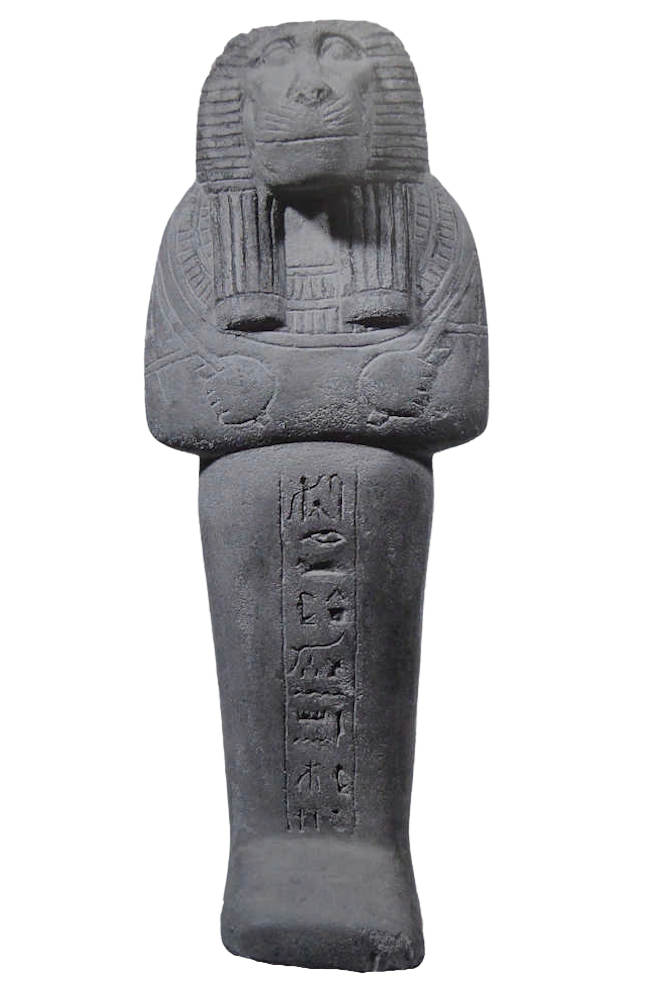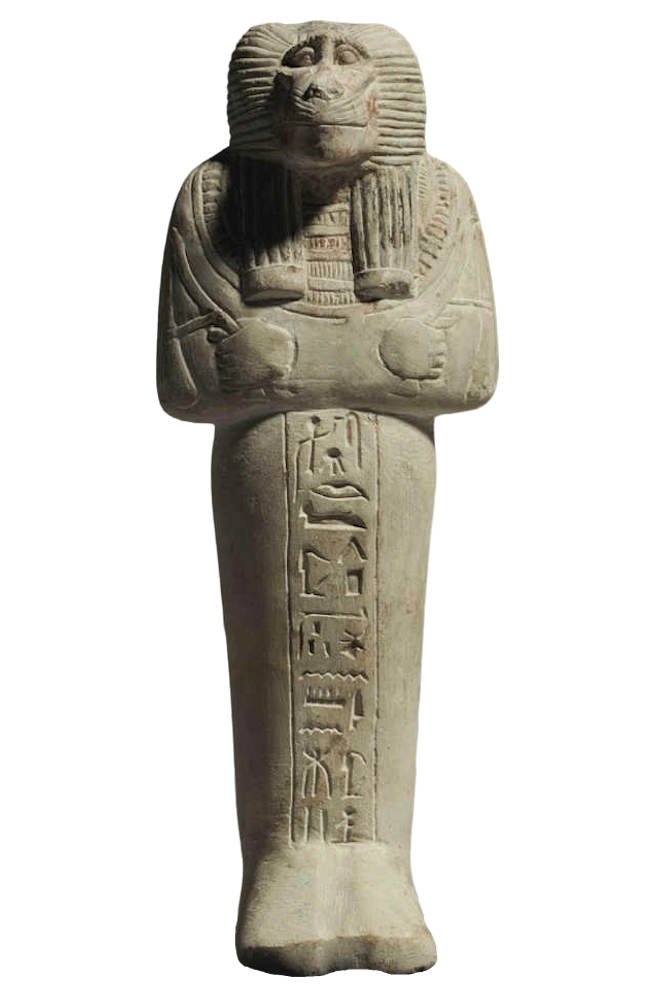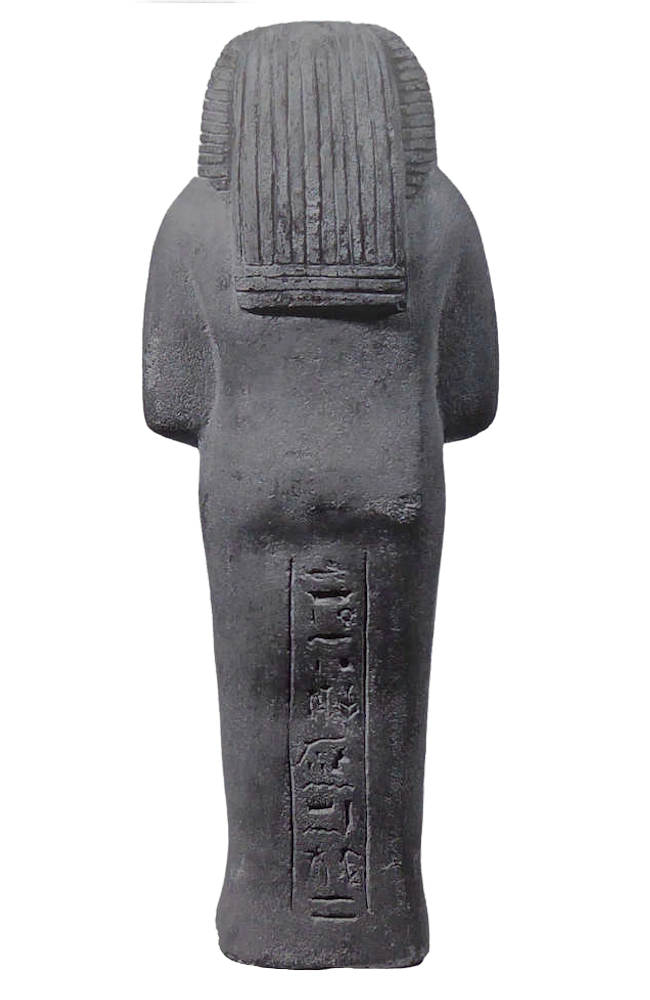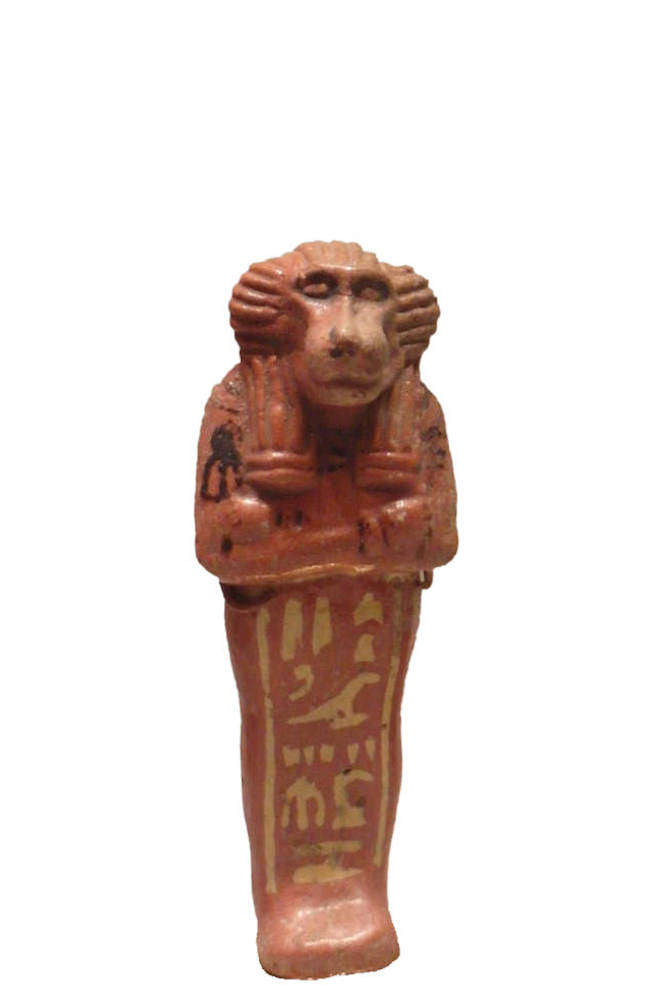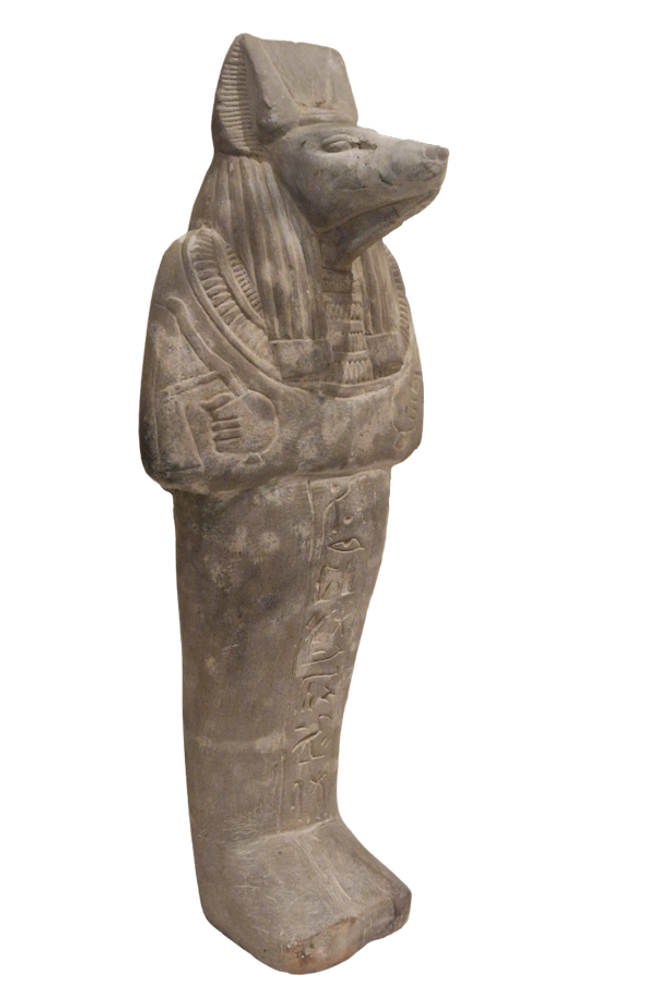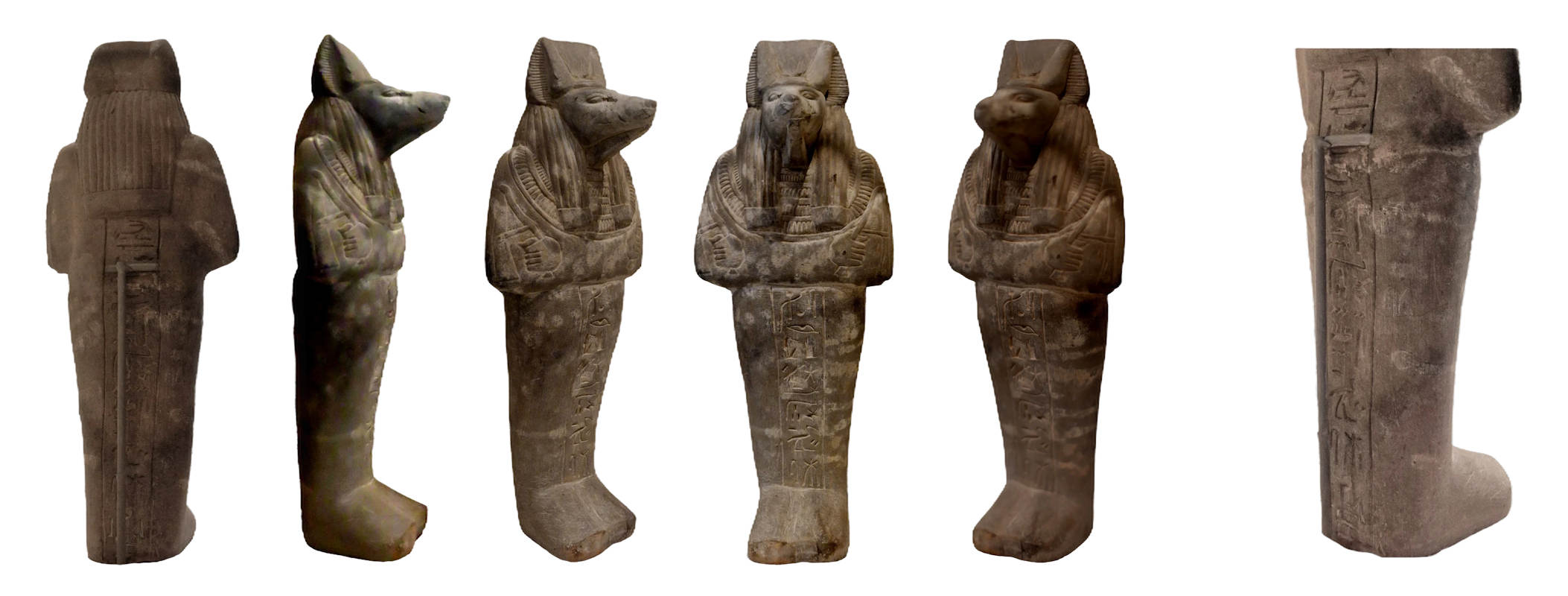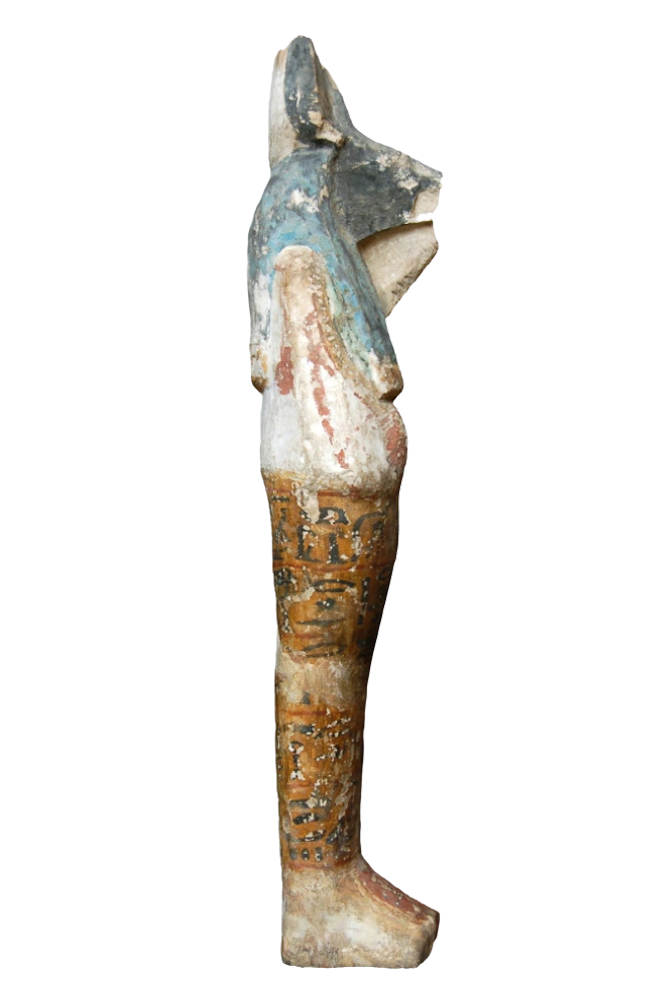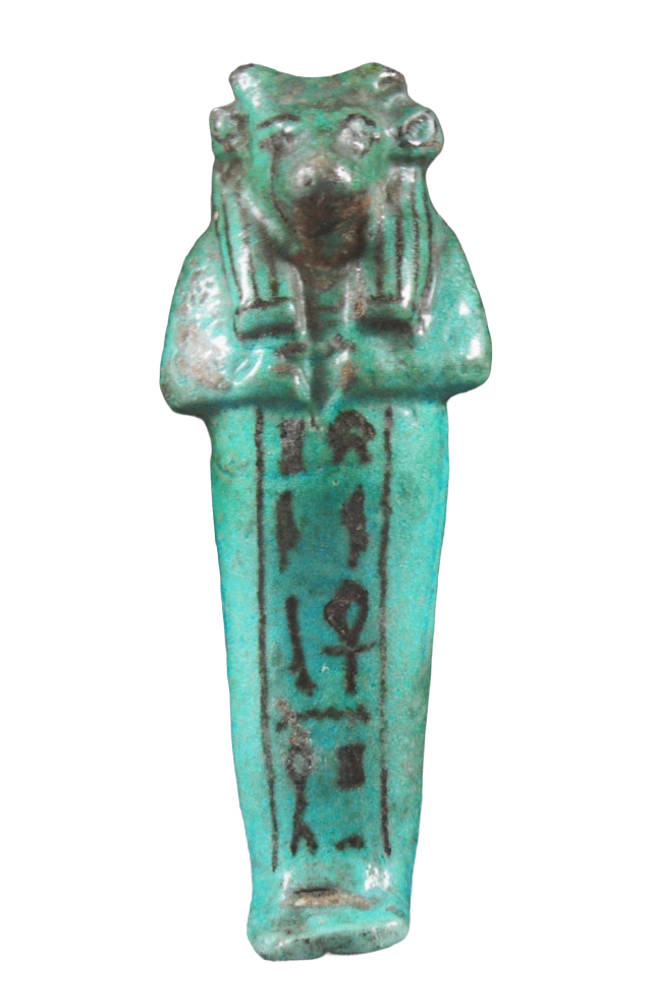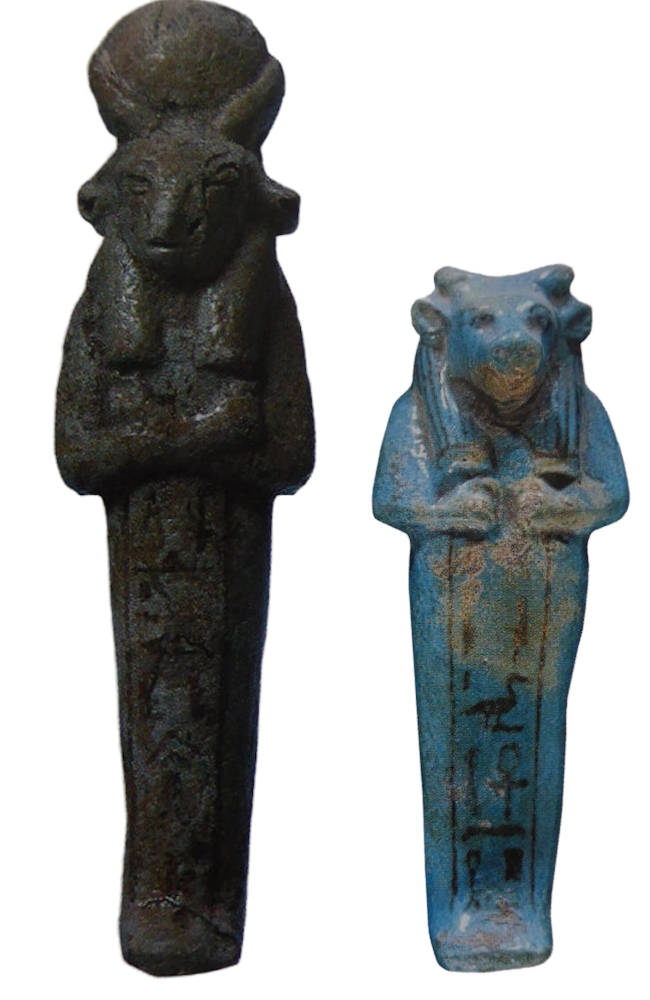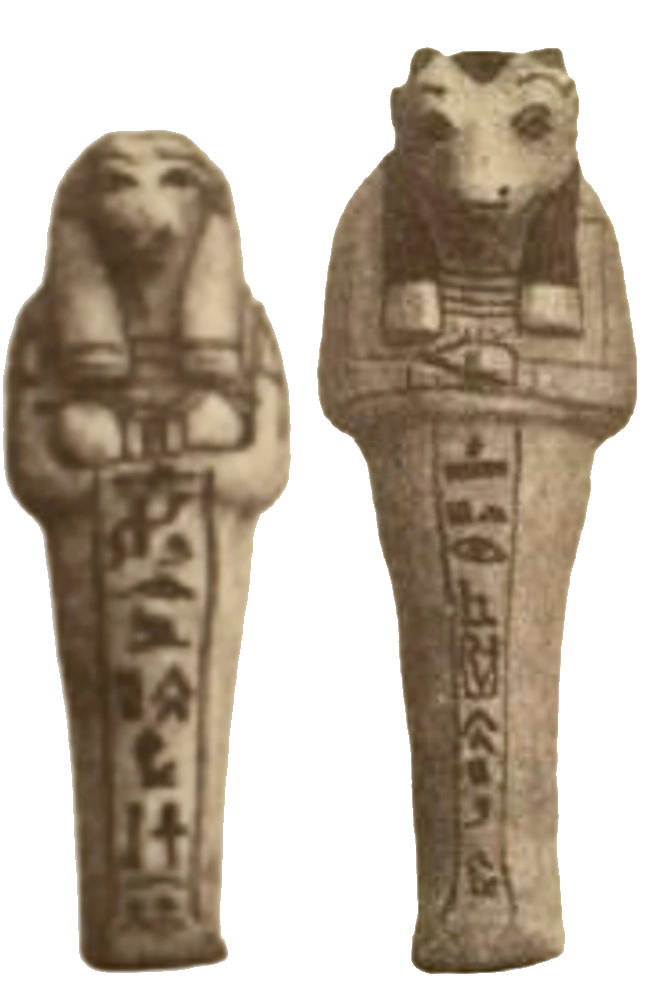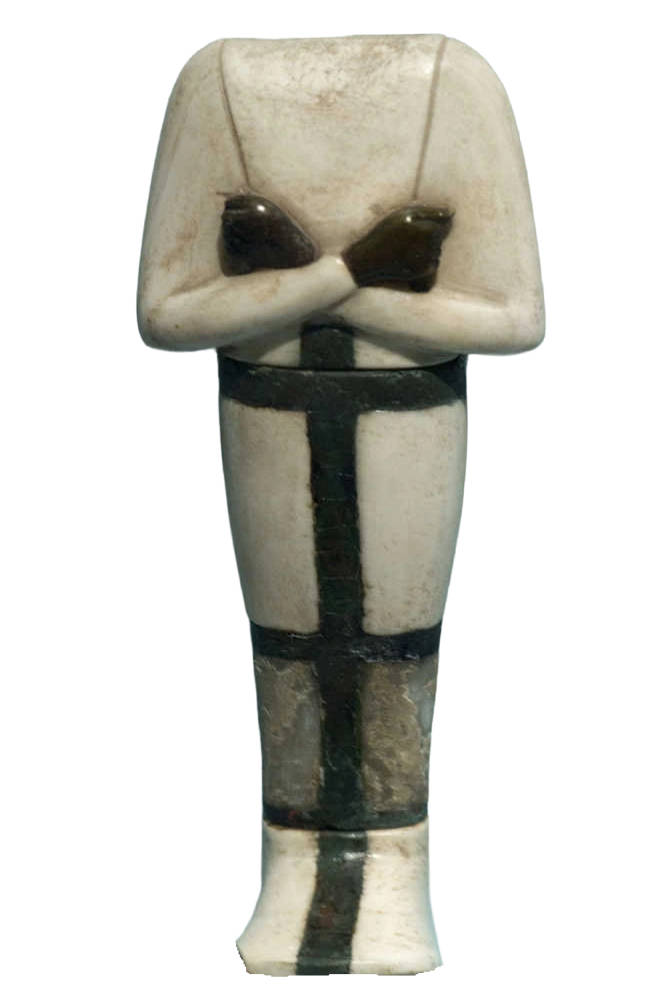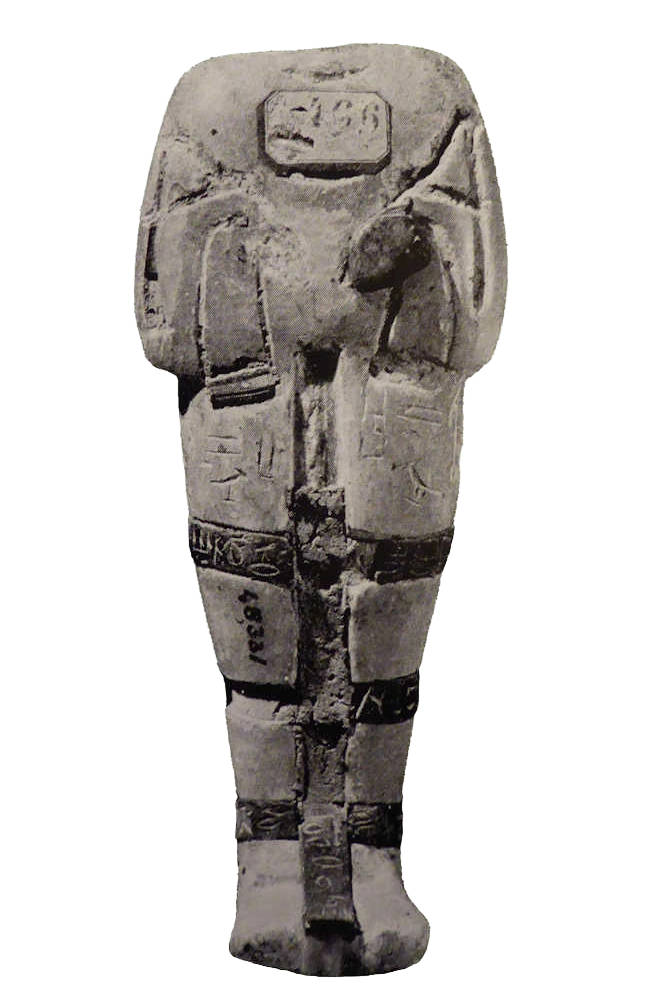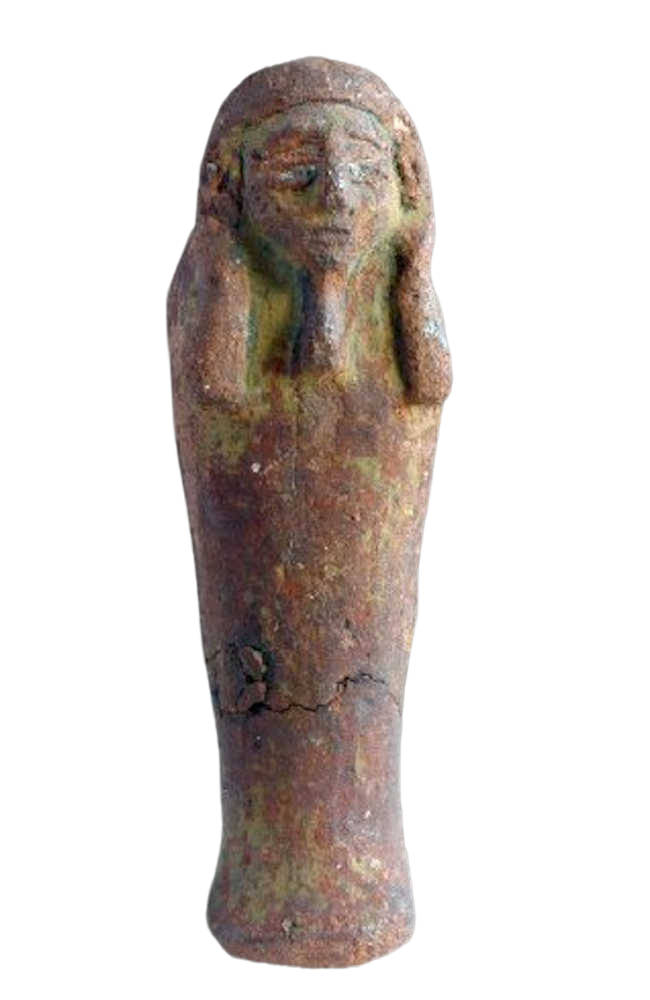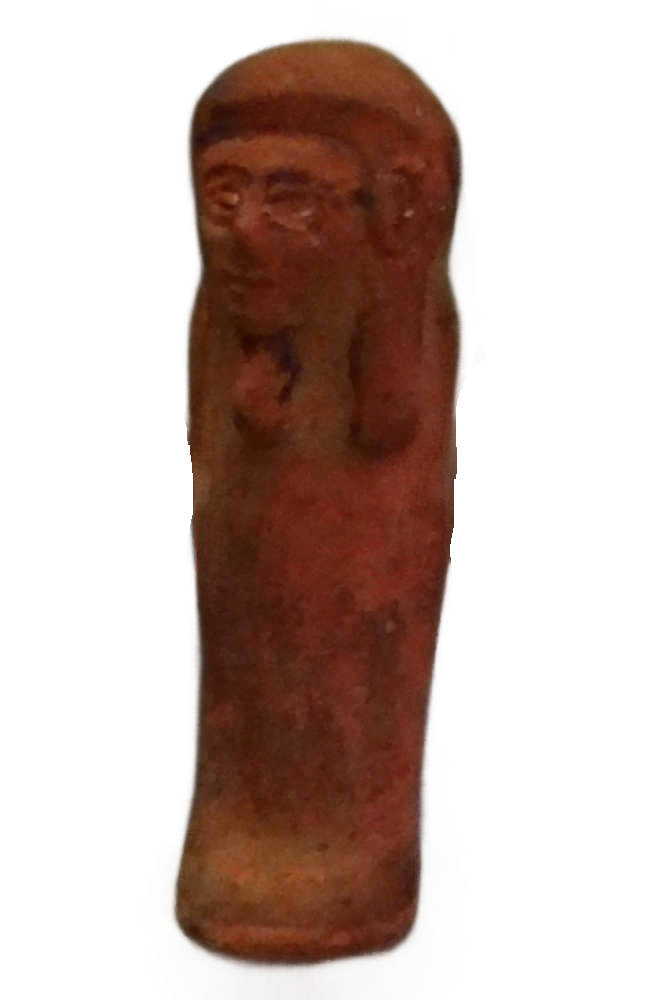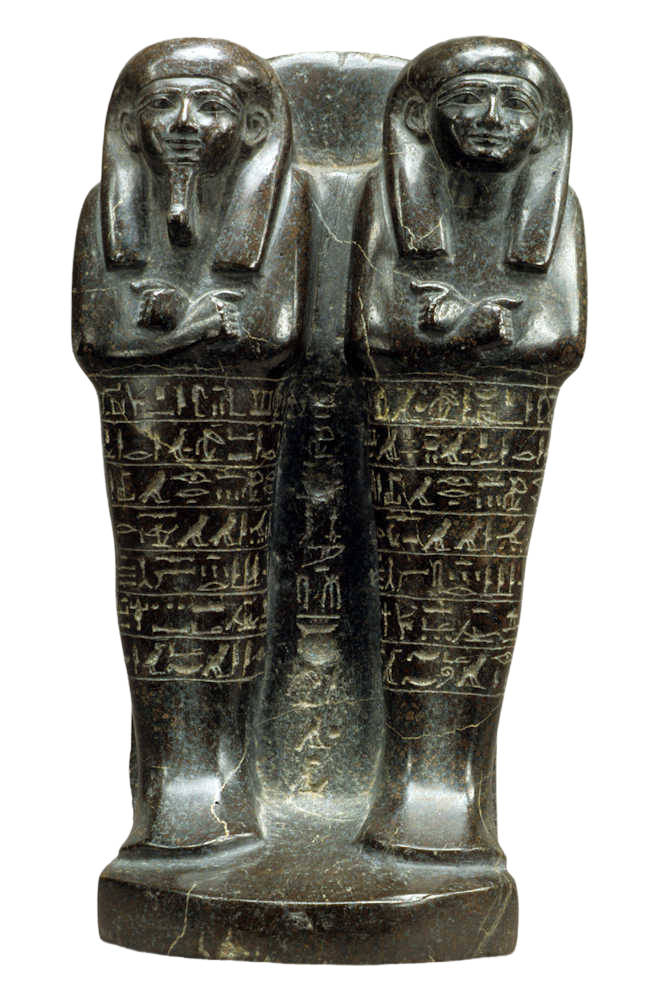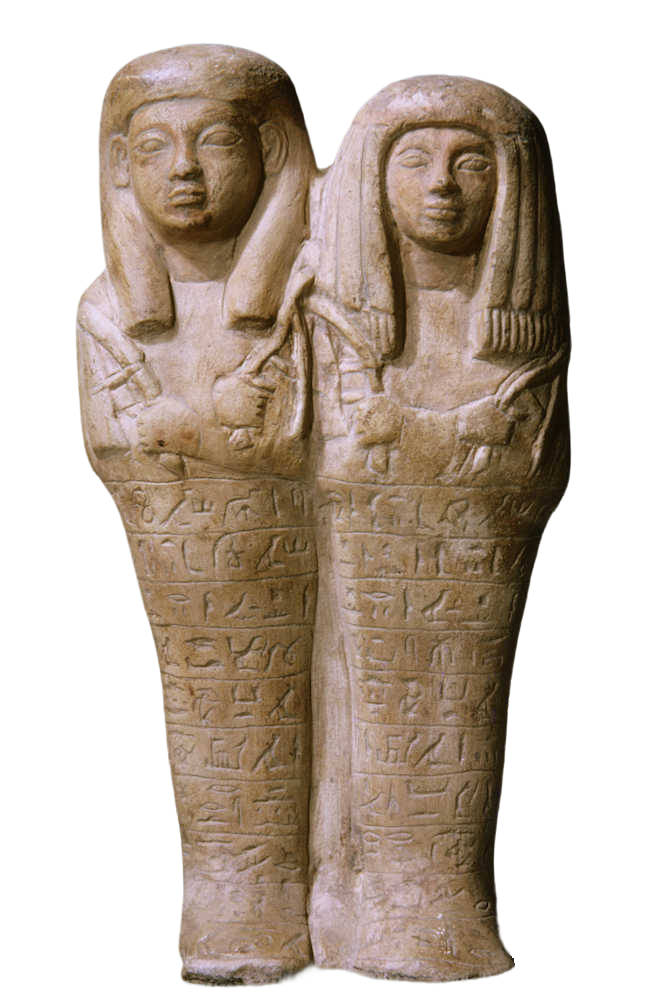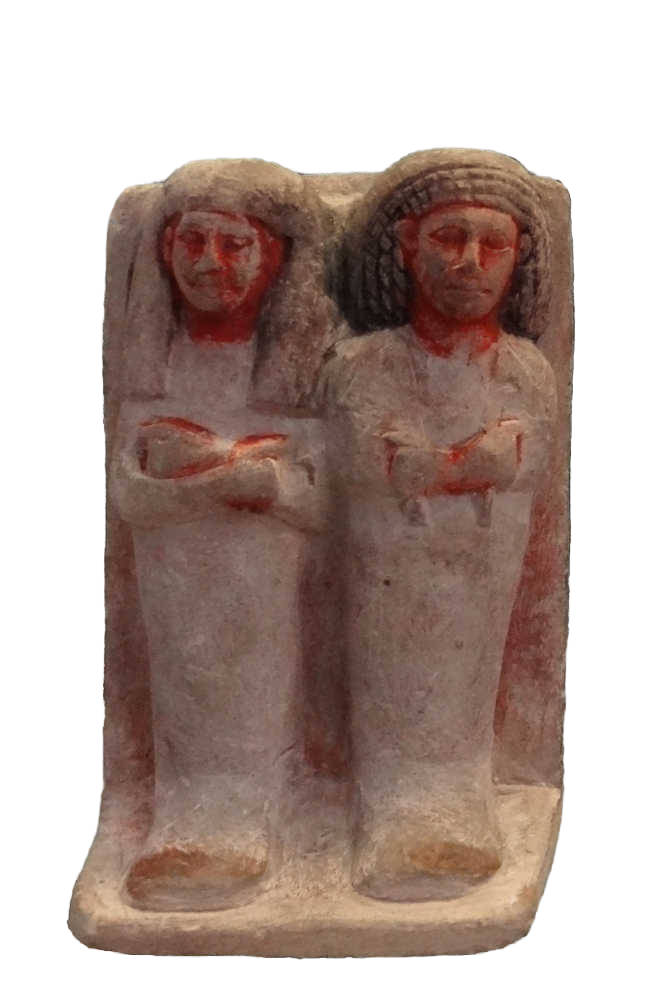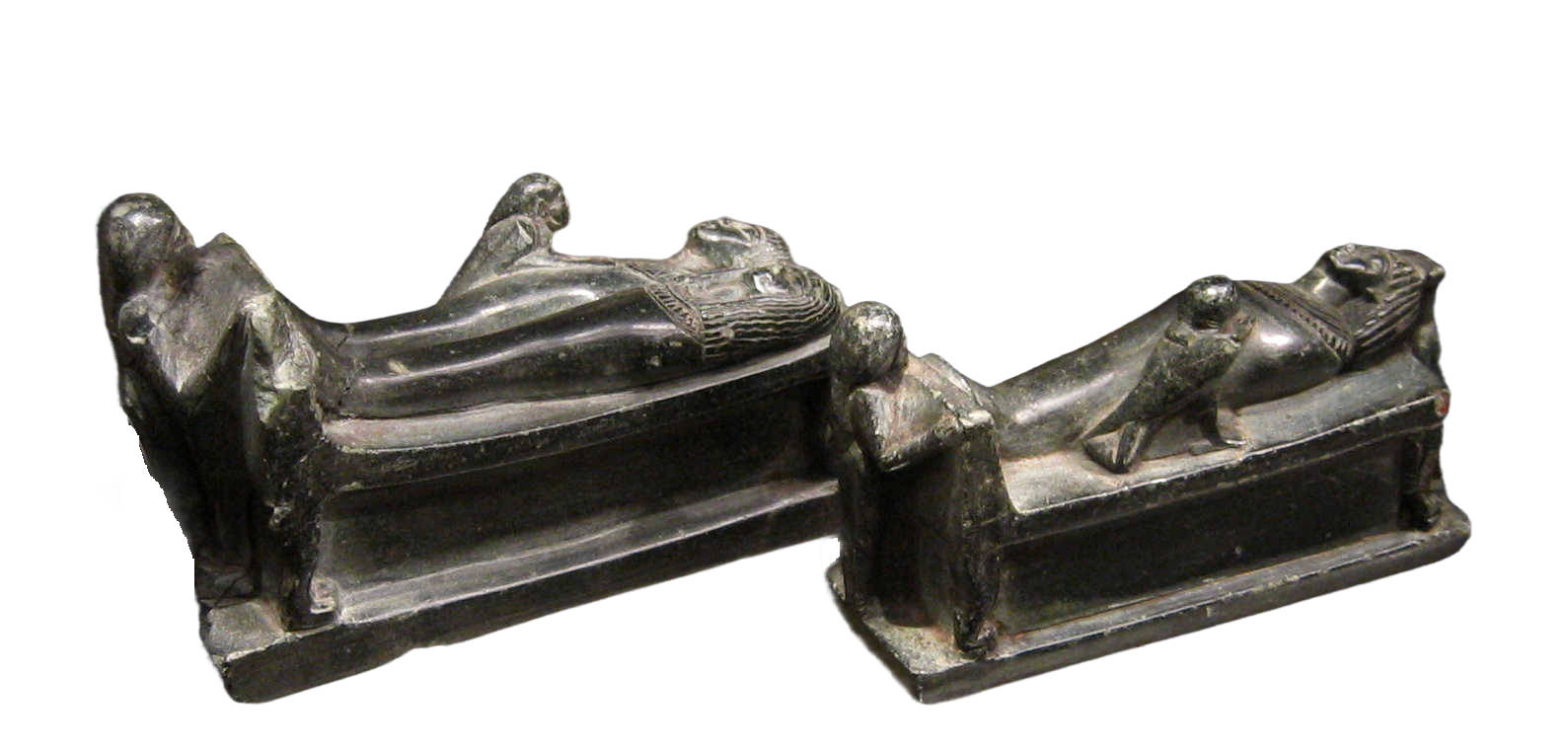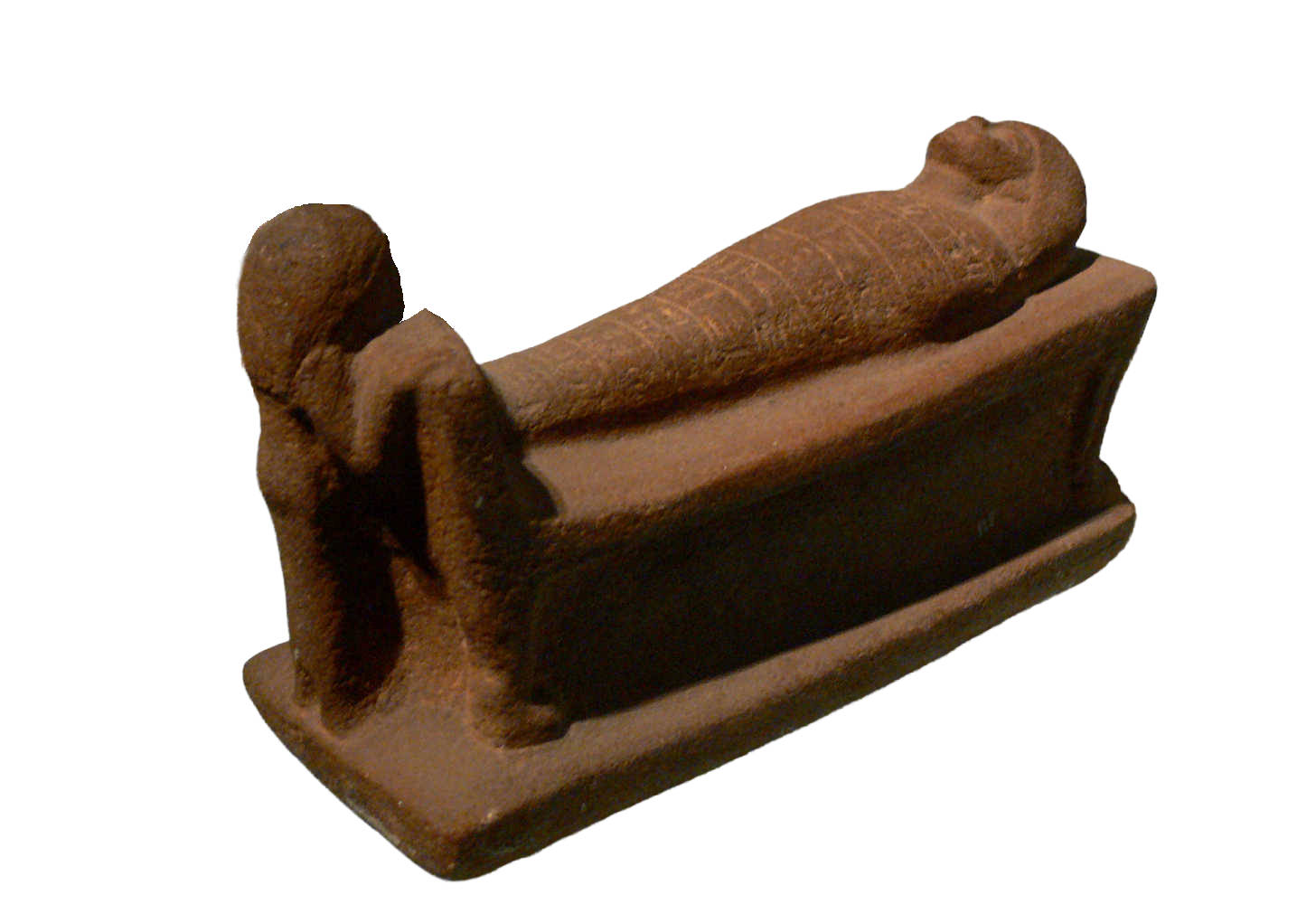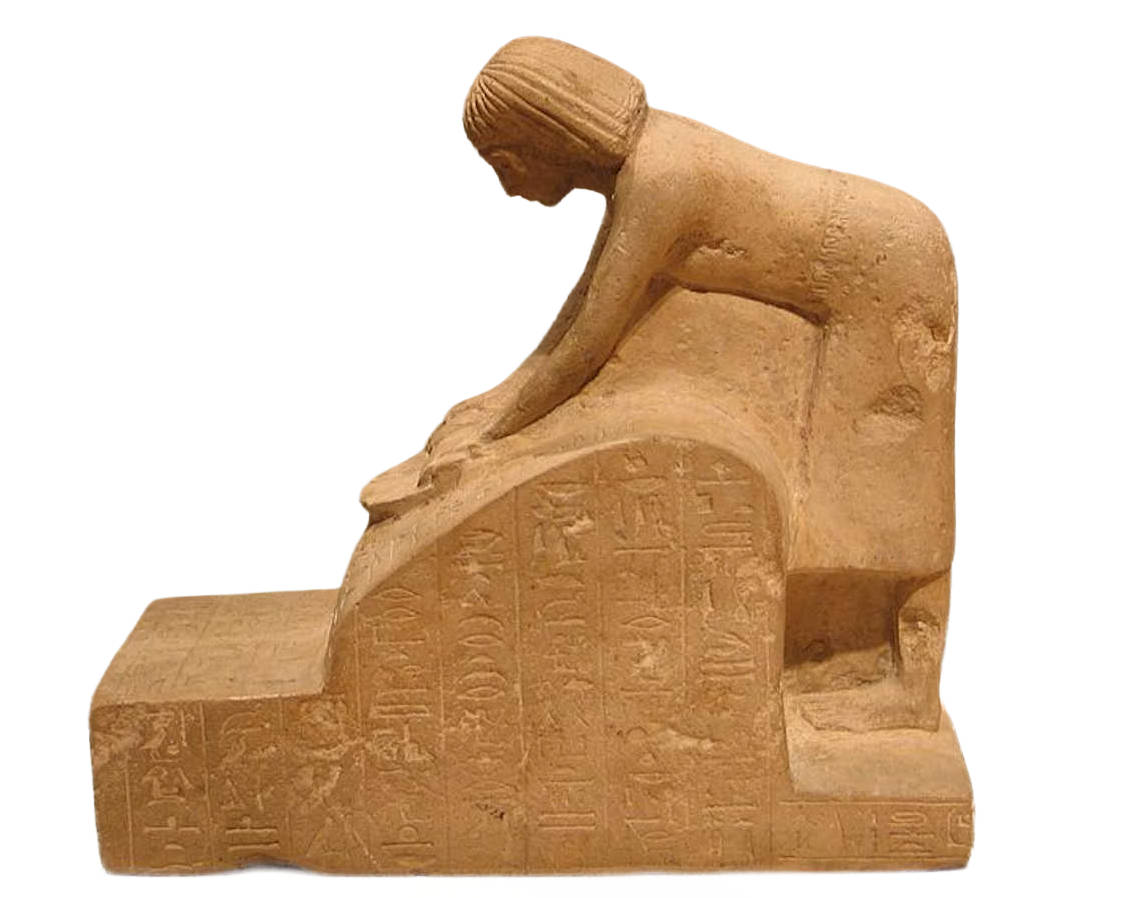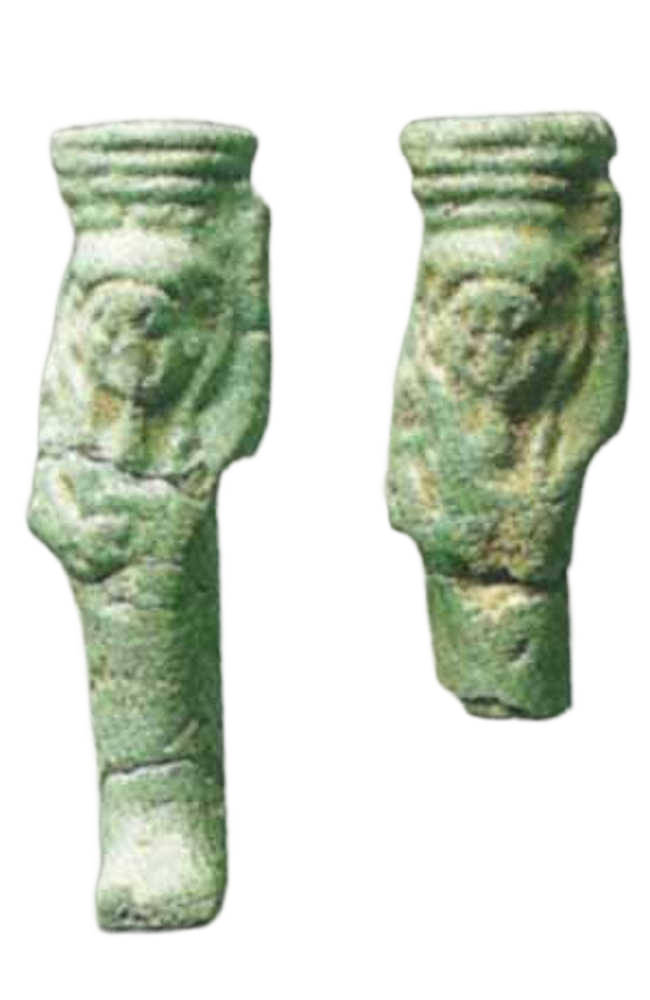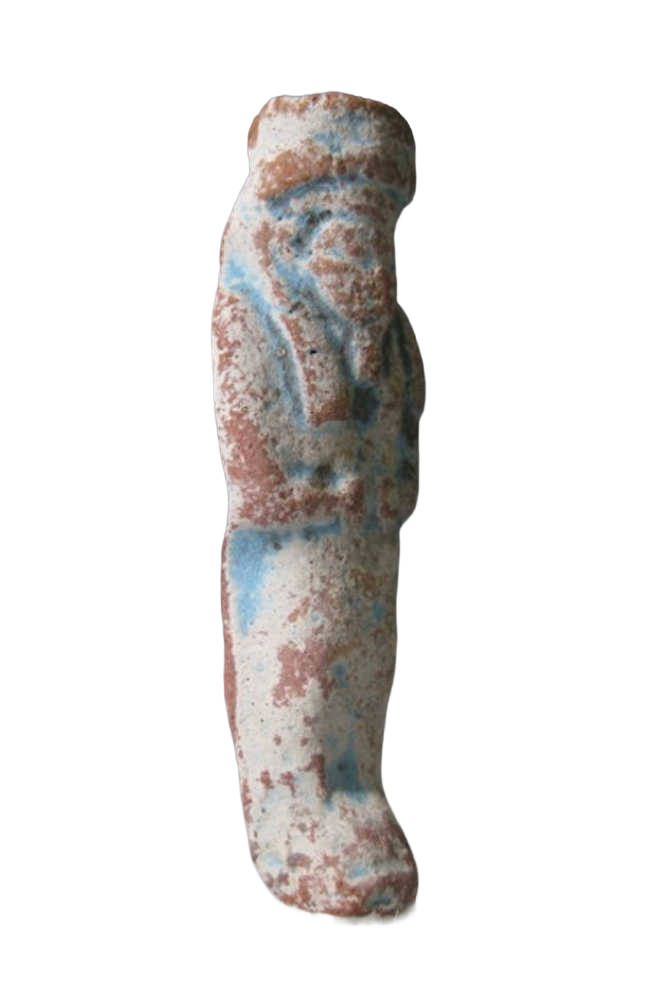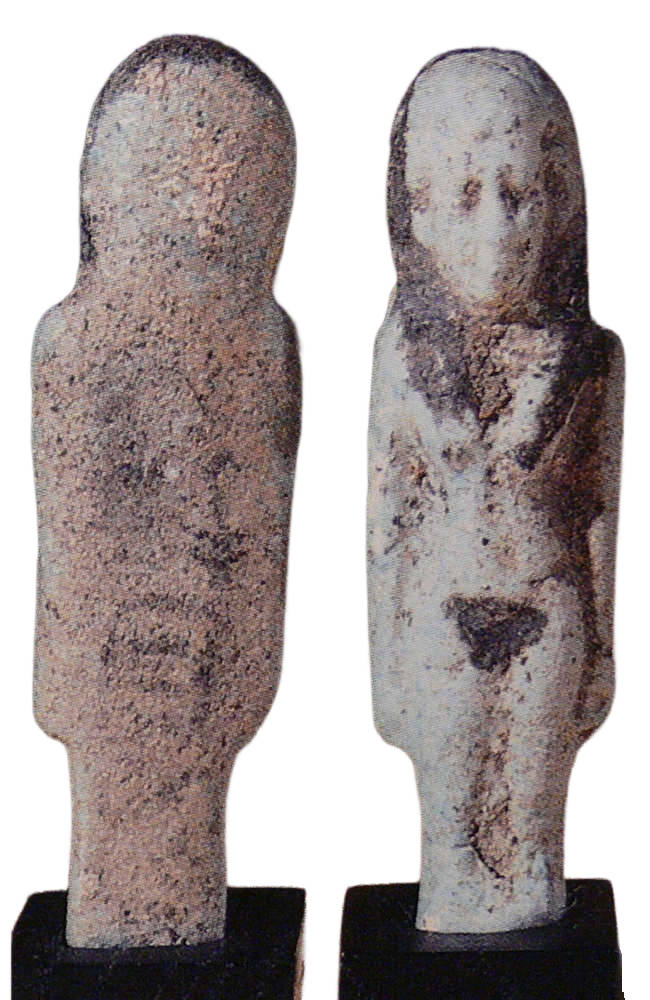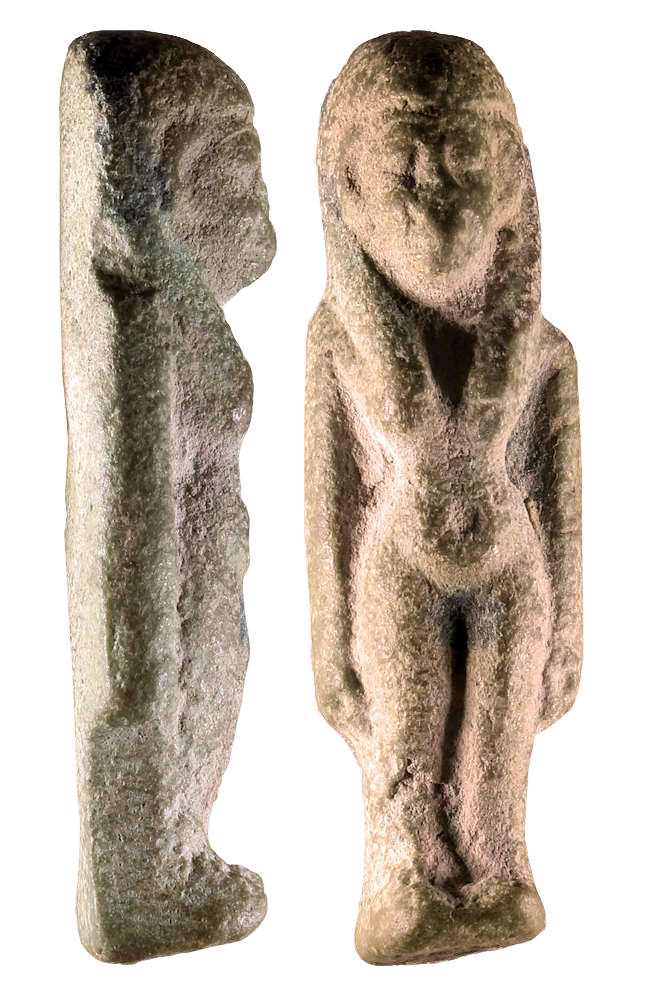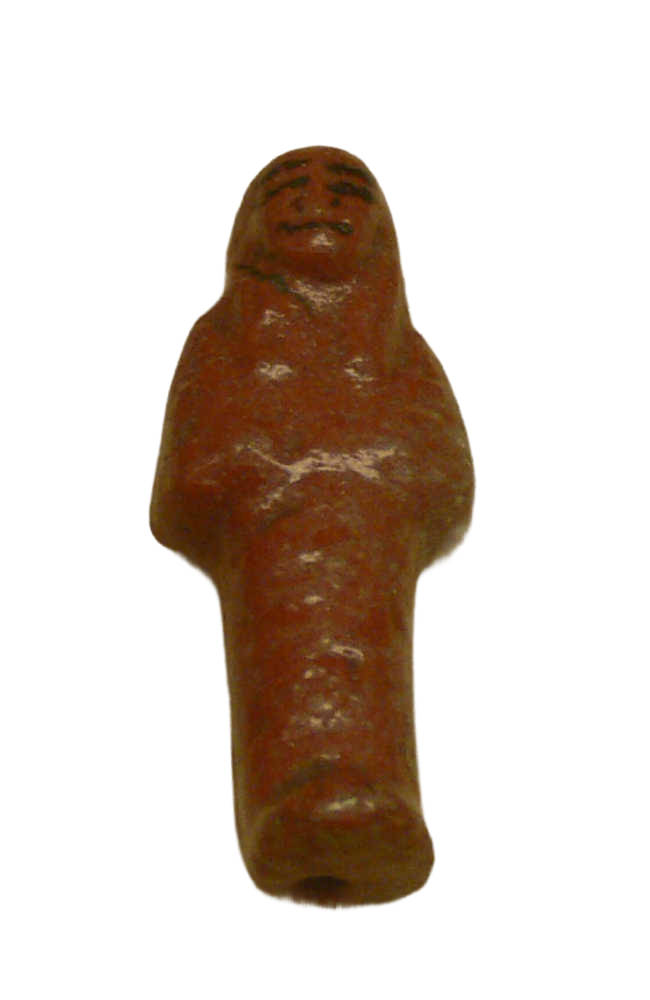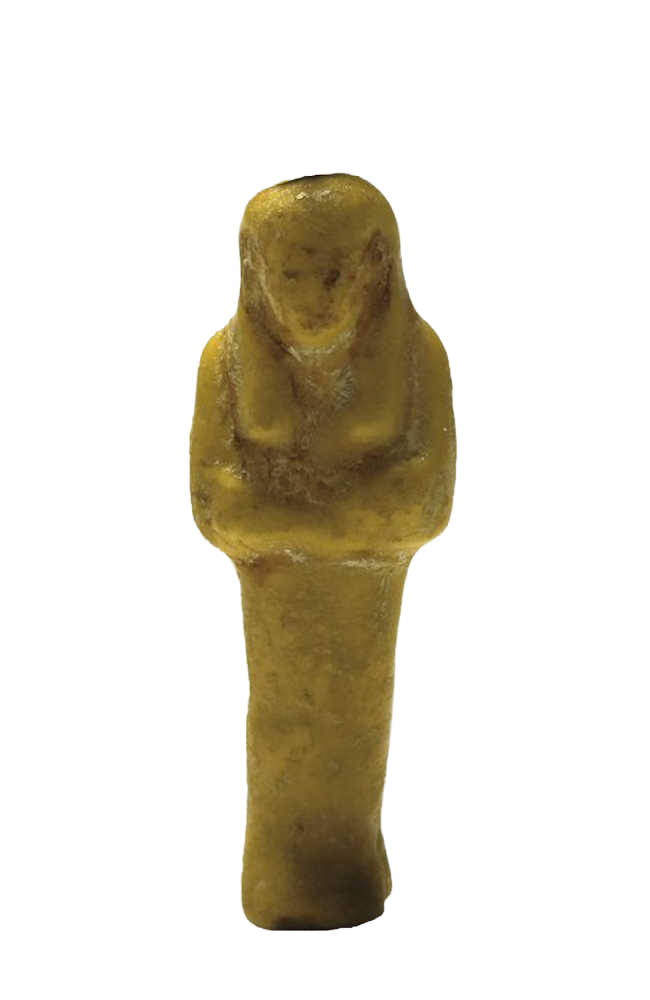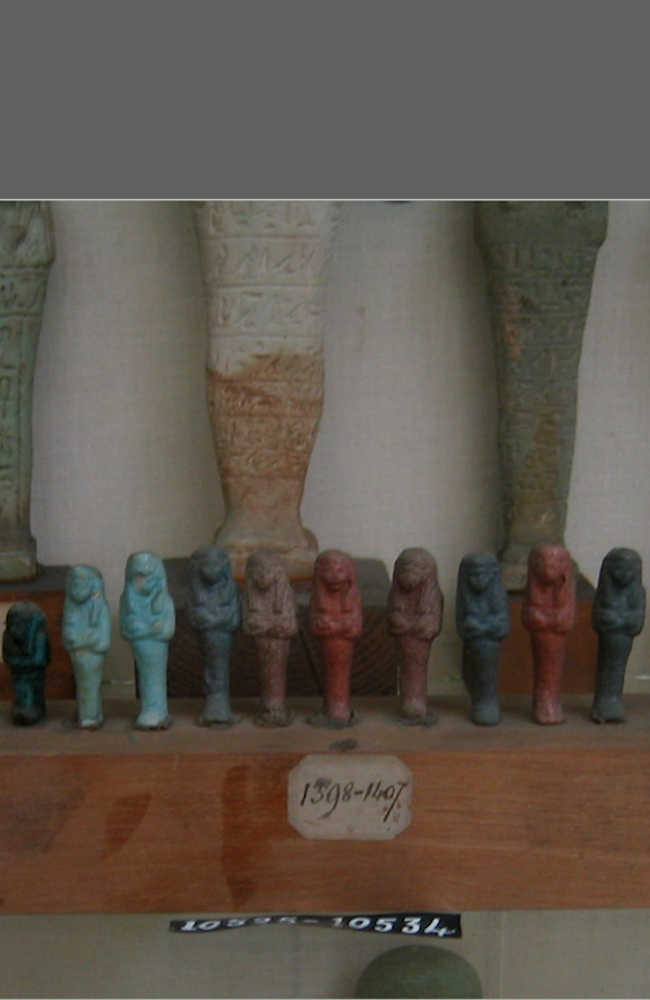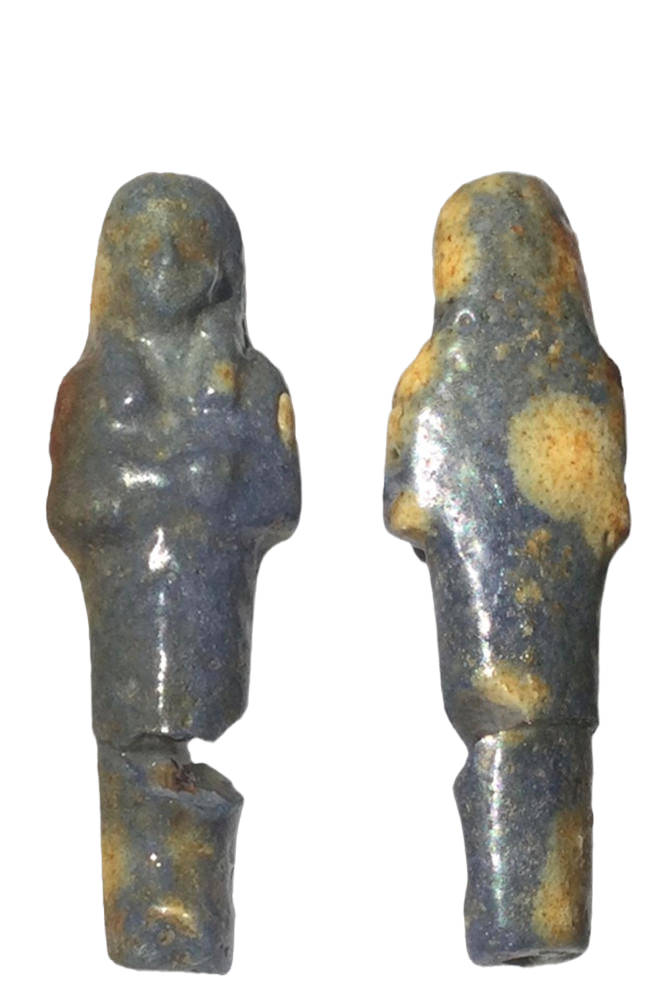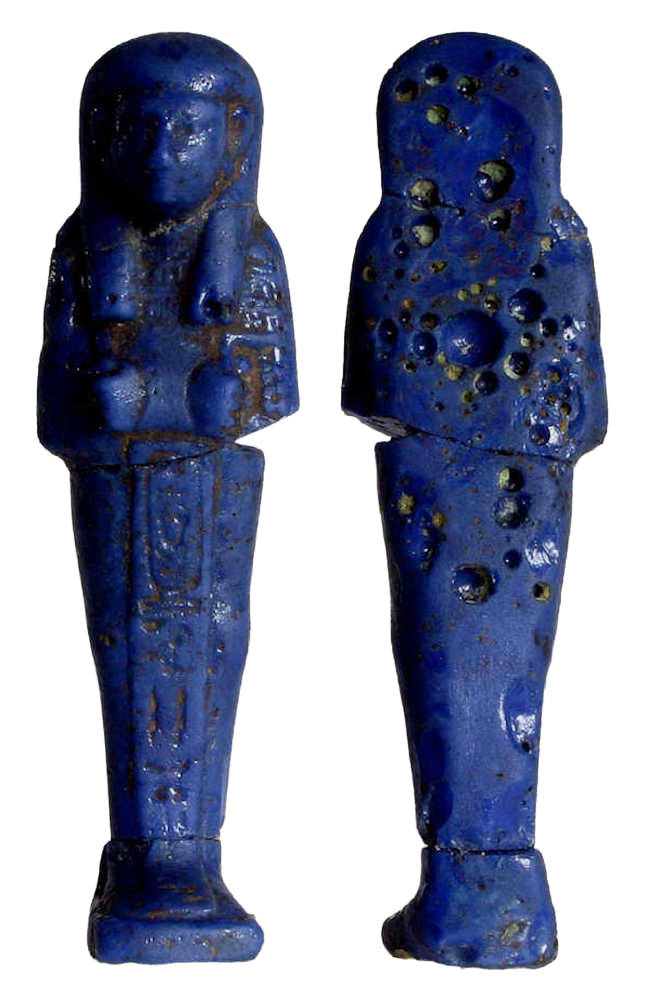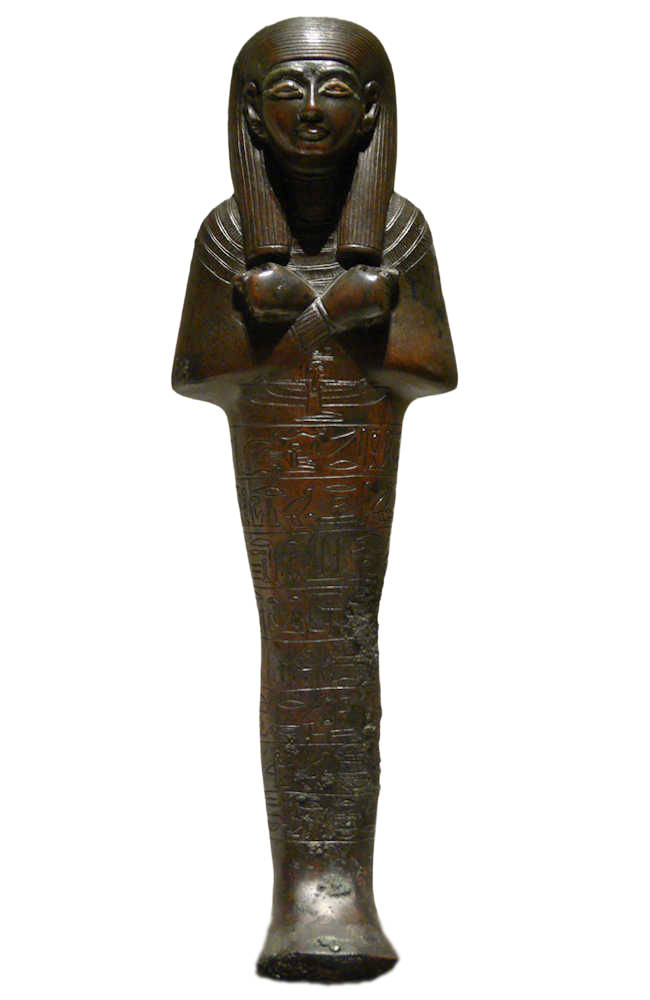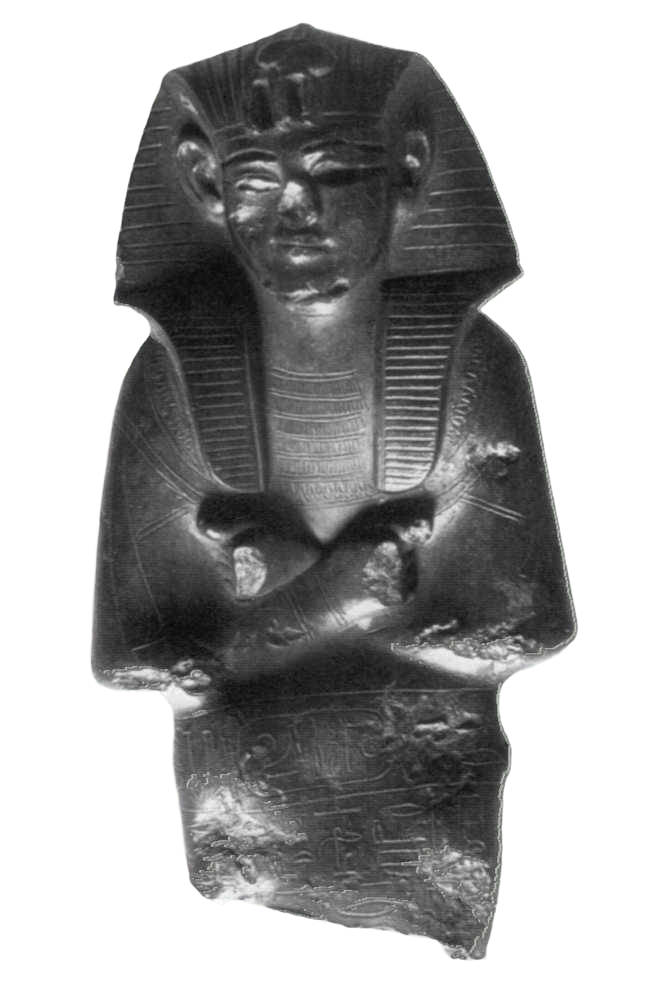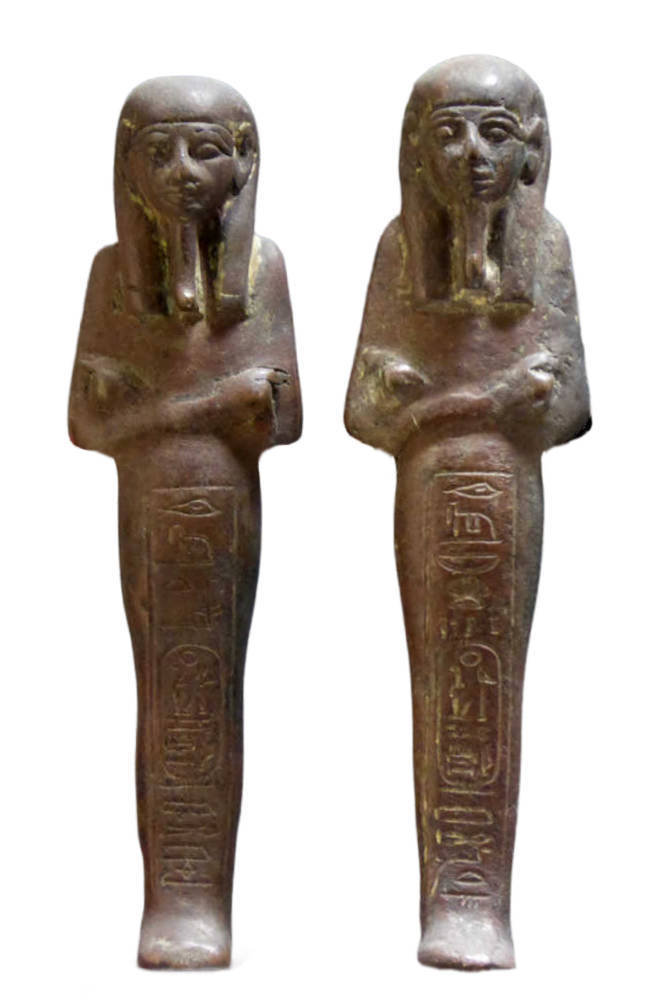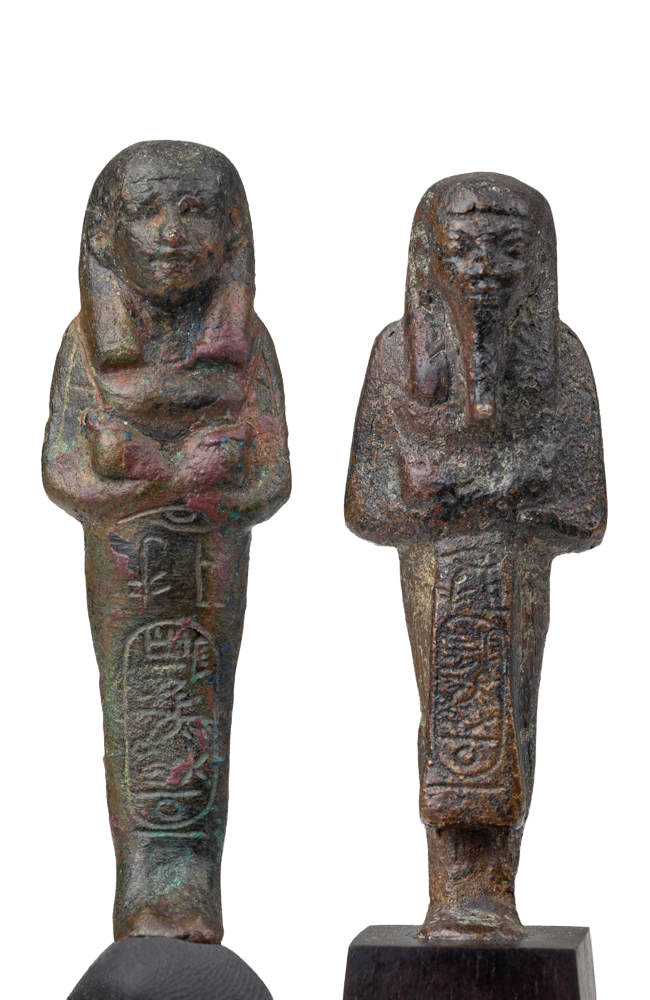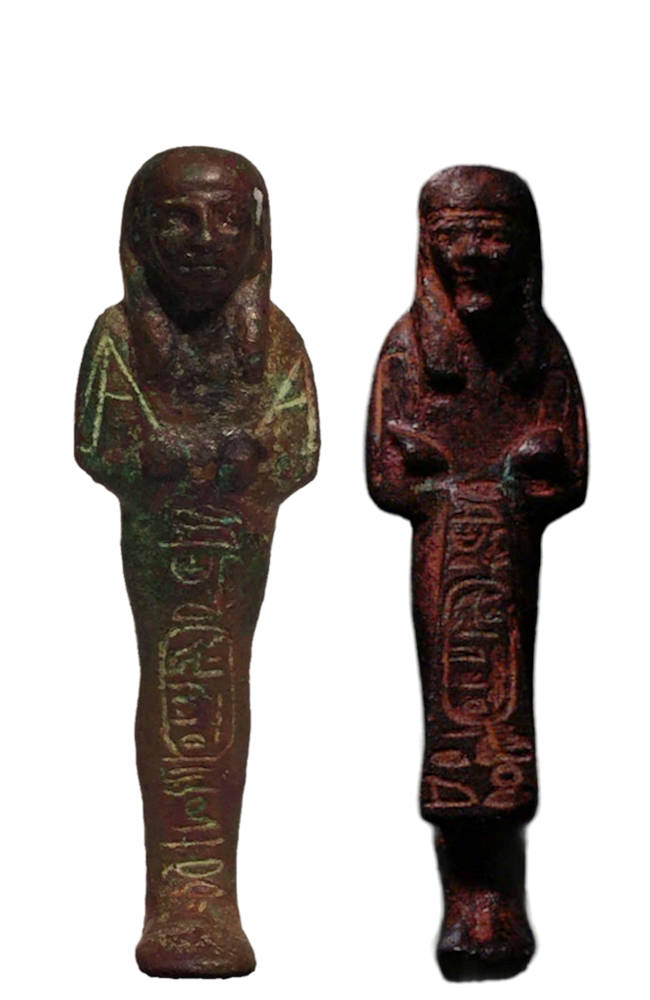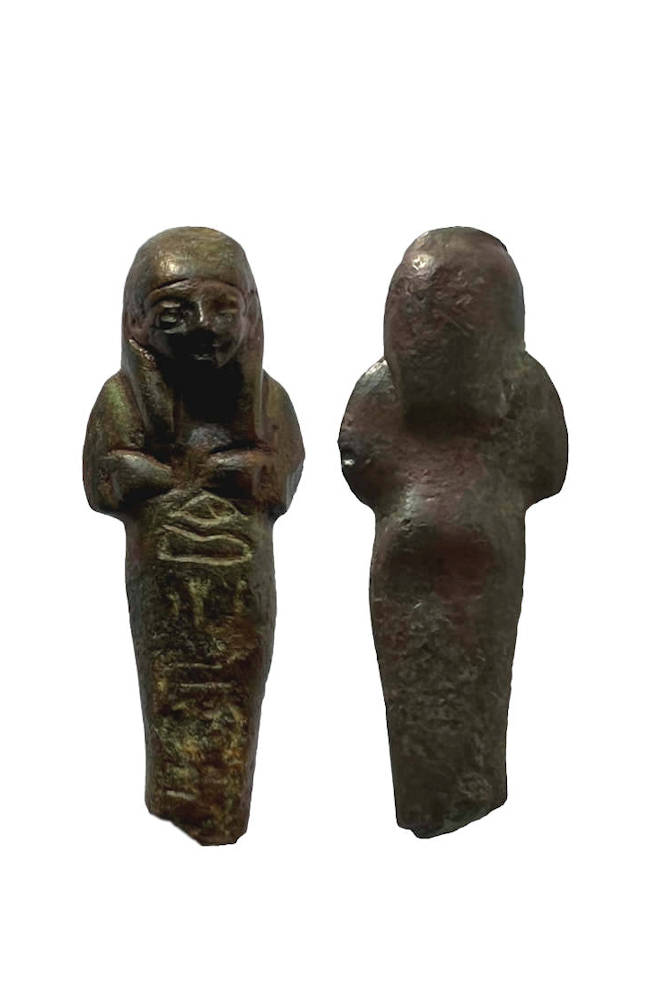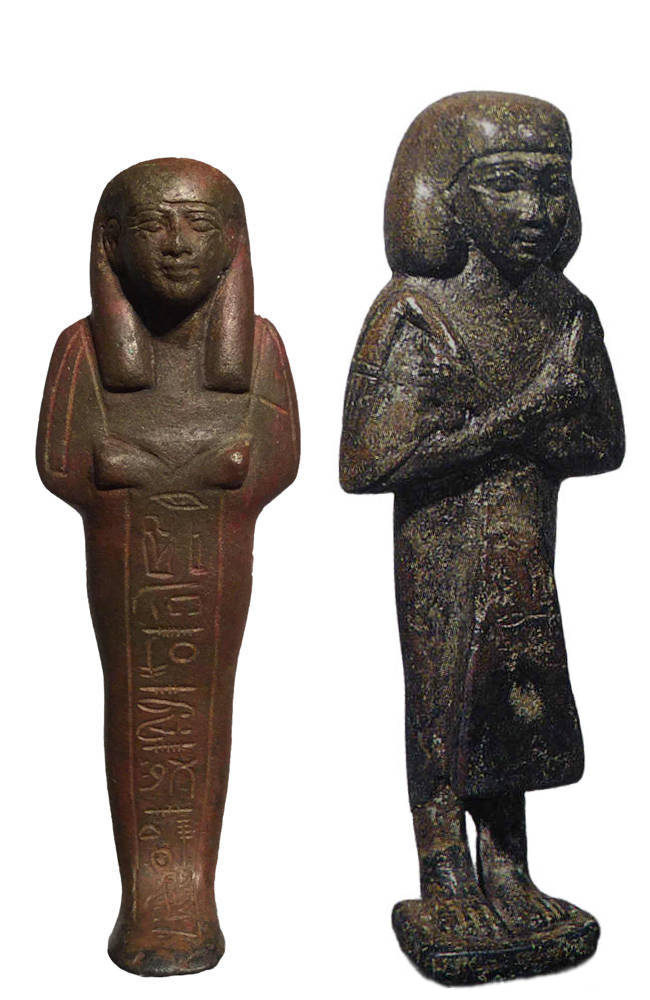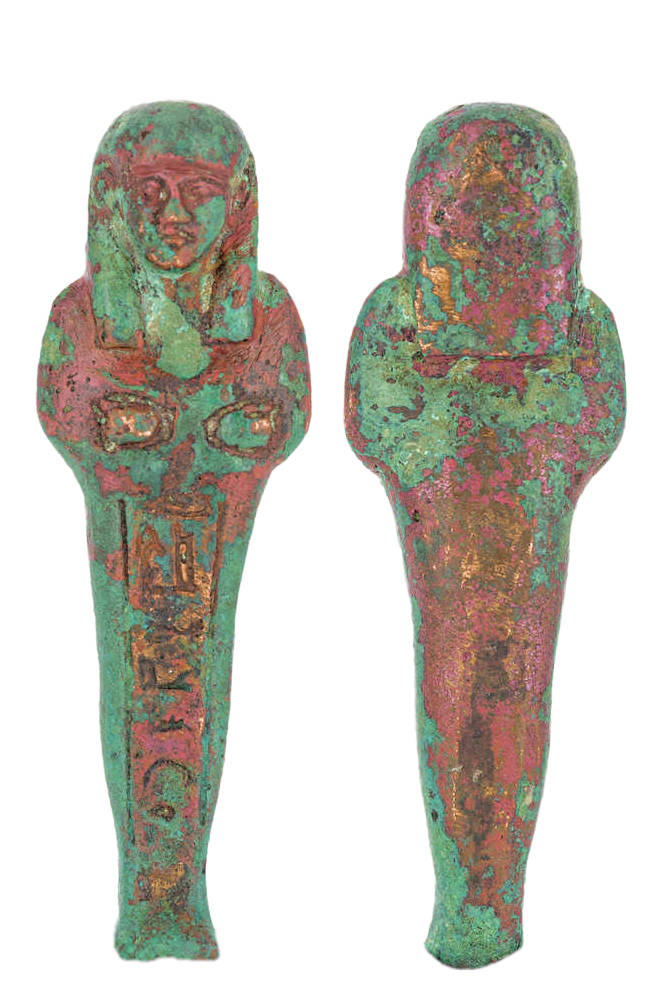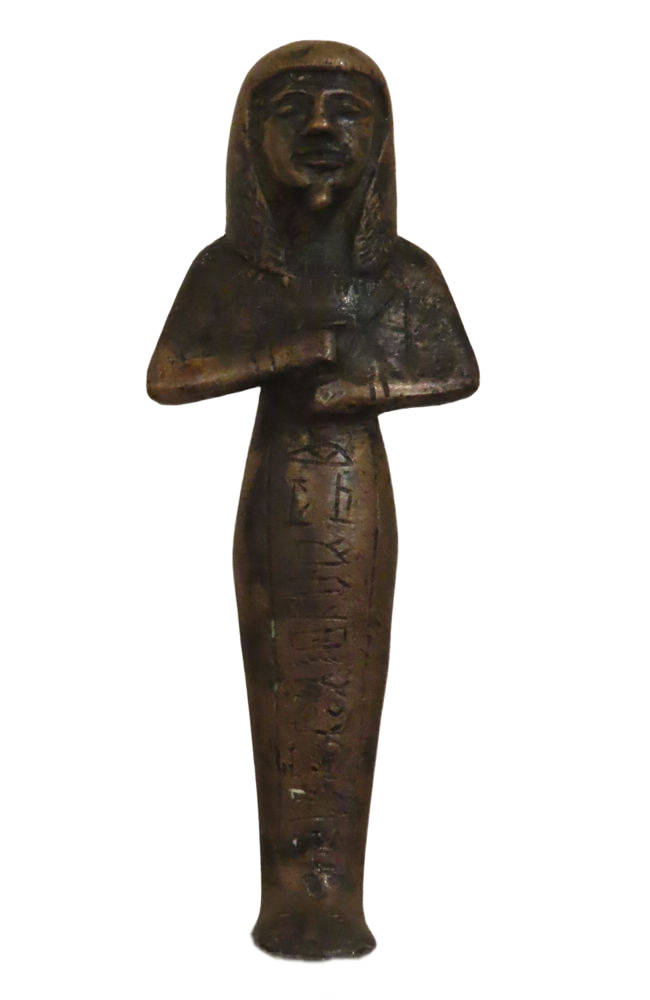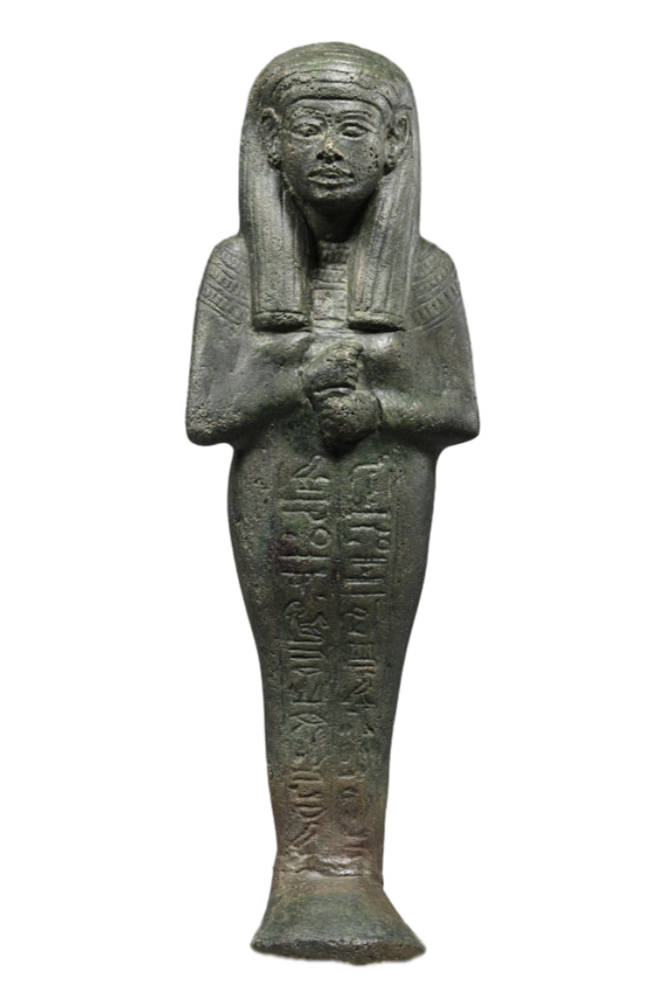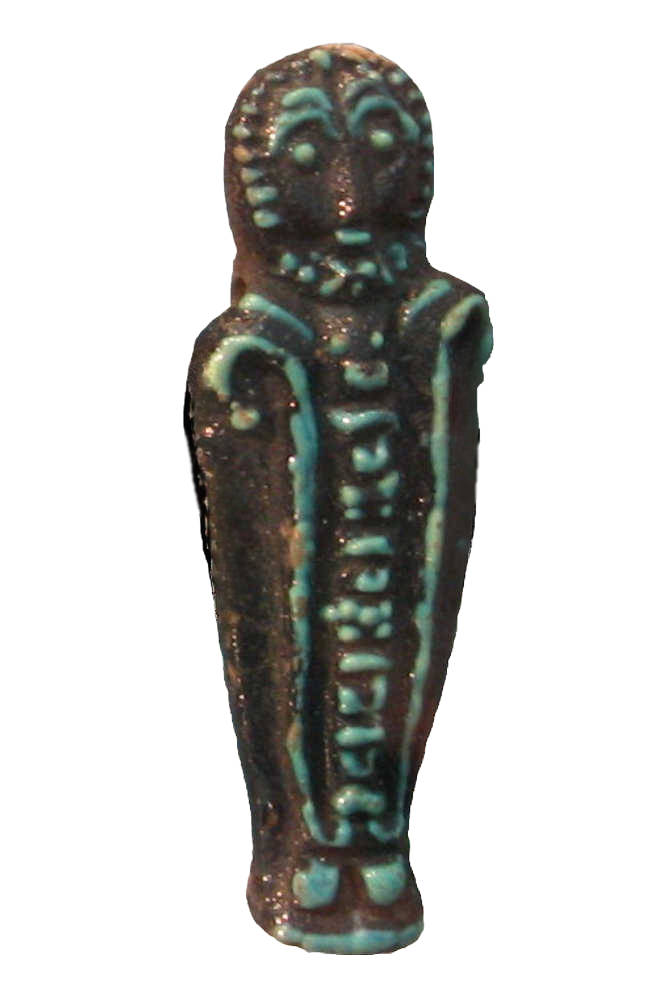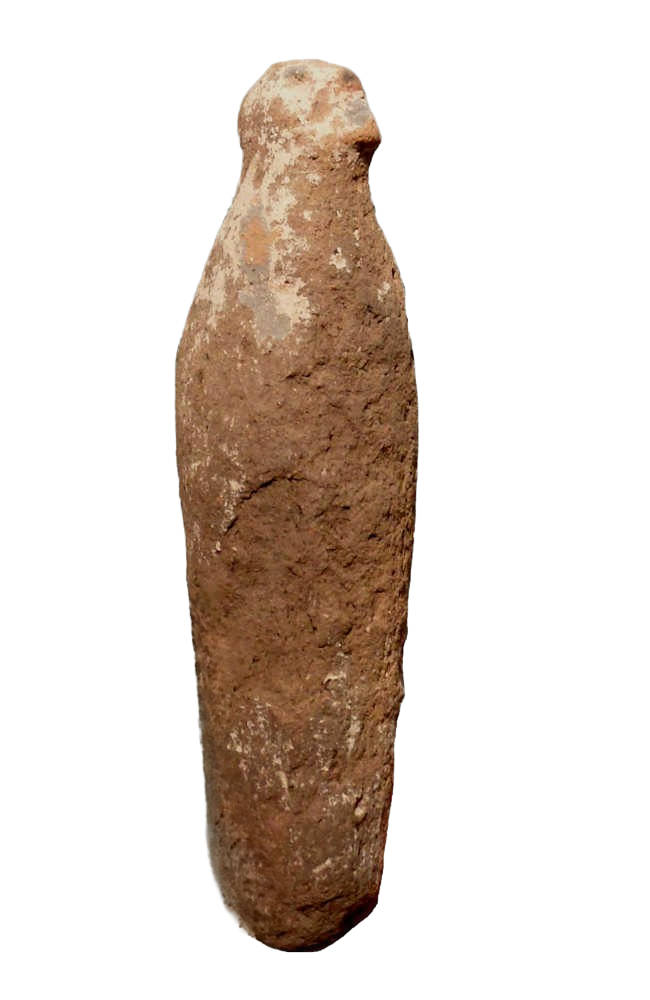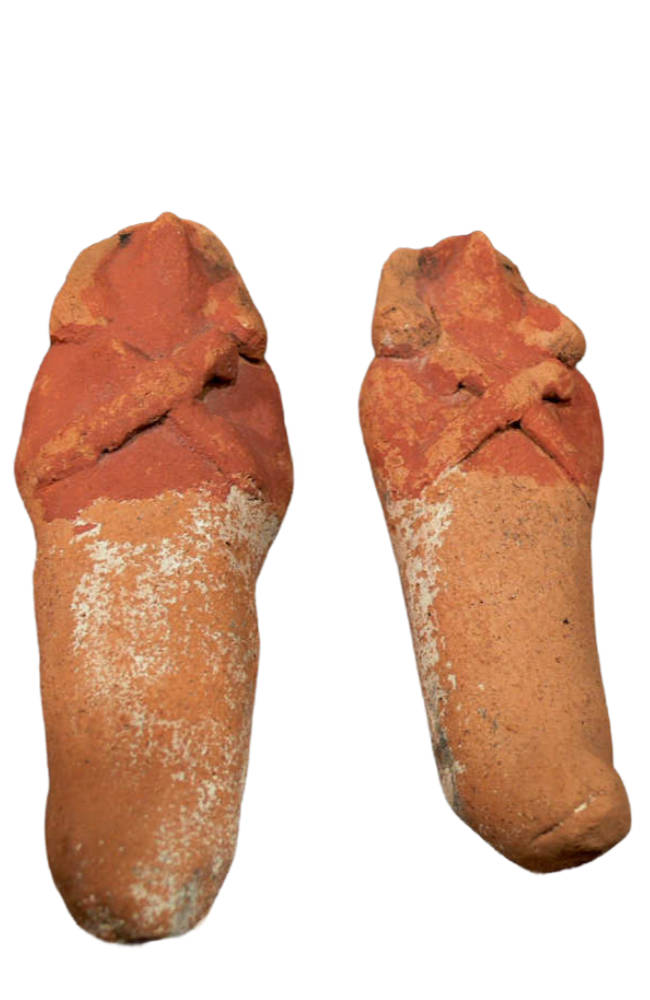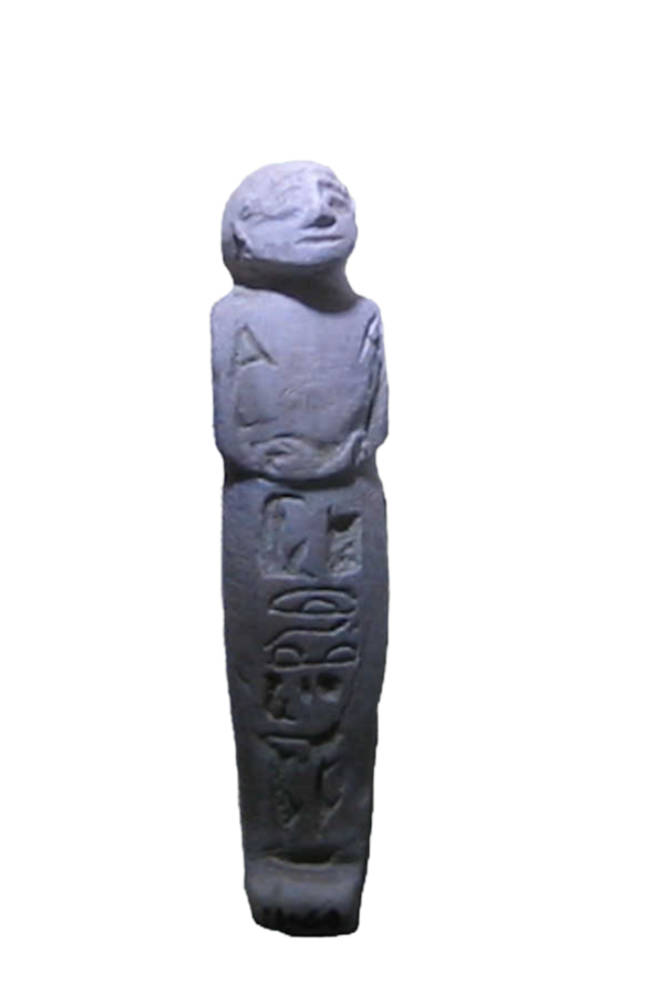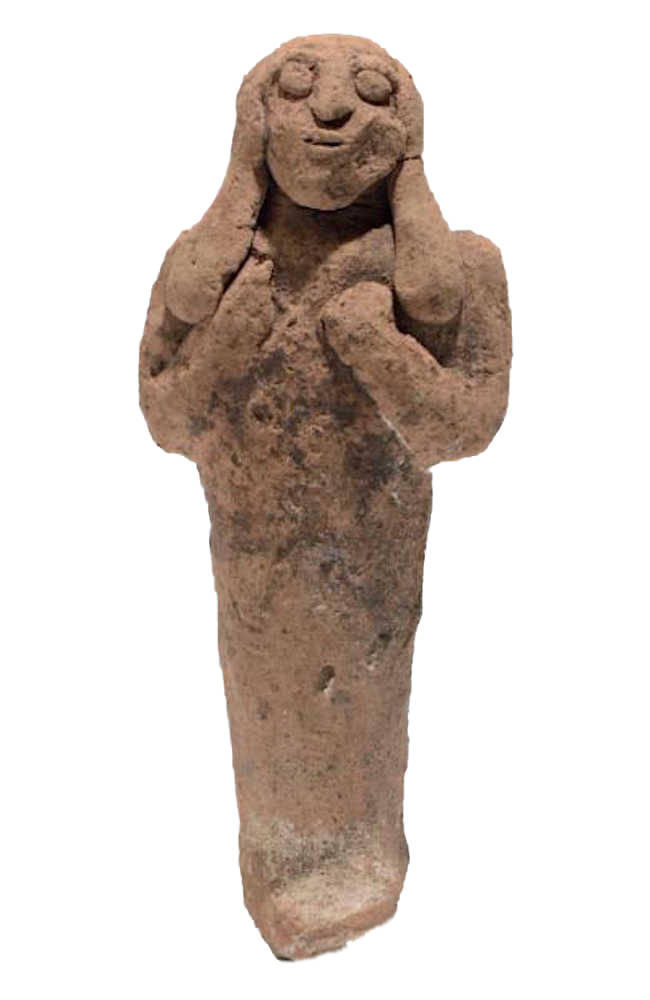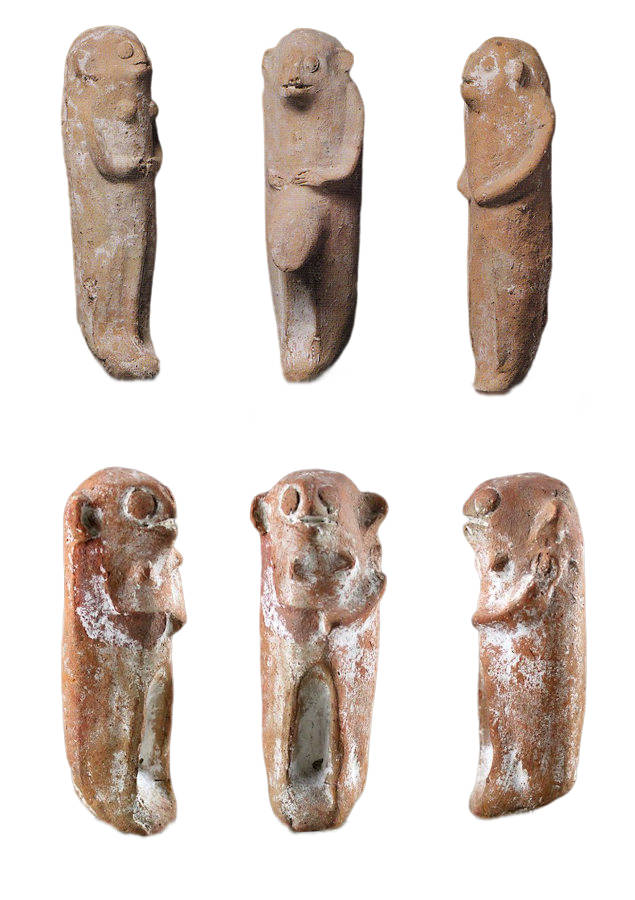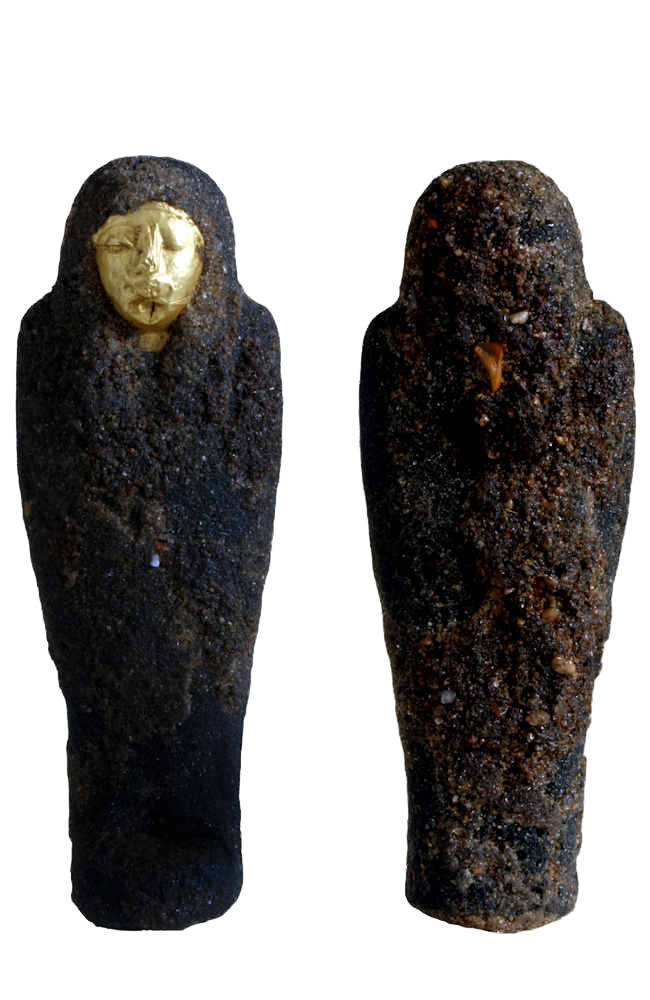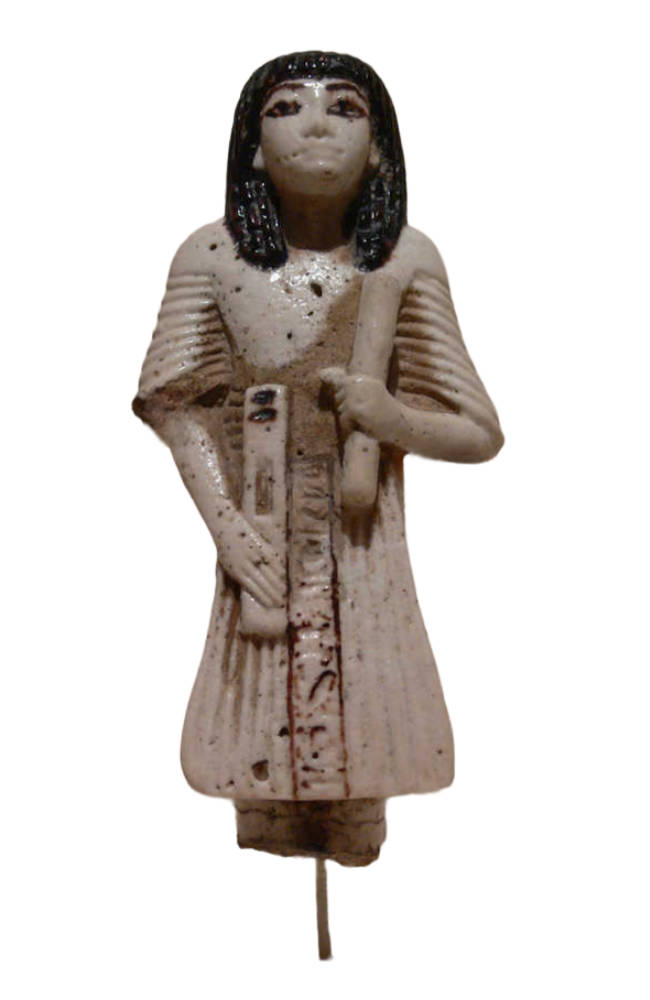Rare and special shabtis
Baboon-headed shabtis (Hapi)
Intriguing shabtis with well-detailed baboon heads. It is suggested to be a personification of one of the sons of Horus, Hapi. His brothers are Imsety, Duamutef and Kebehsenuef. Shabtis with these features are very rare and there is no Imsety or Kebehsenuef known from this group. It struck me that there are two baboon shabtis for the same owner and no evidence of provenance. Nevertheless, I am convinced that Djehutymose Horus sons sons as funerary goods in his looted tomb(s)
Many types of shabtis are known for Djehutymose. Faience versions (no. 1 – 17 cm, no. 3 – 16.5 cm, no. 5 – 12.5 cm) with inlaid hands and face, but also beautiful versions in limestone. One of these has been suggested by Christies (not by John Taylor) to be the Imsety of this Duamutef series. I doubt that given the execution and ornaments held by the shabti. See also, for example, this beautiful 31.5cm version sold in 2010 for USD 1,314,500 and BM EA 47398 in the British Museum. Here an overview with estimated height differences
Weiss’s report states that in 1912, in the tomb at Tuna el-Gebel where 80 Djehutymose shabtis were found, there were two sarcophagi belonging to other owners. Just before the excavation, the tomb was looted and it is possible that the beautiful baboon shabtis and a Duamutef shabti were taken away in the process. It is known that figurines of Djehutymose were sold in the nearby villages and also in Cairo. Porter and Moss report two sandstone shabtis sold in the vicinity. In any case, there is no record of an official excavation from which these figurines came
The granite sarcophagus of Djehutymose (now in Cairo) was found by the Antiquities Services in another 11.5-metre-deep pit in 1915 (See Darresy). In the adjacent room (looted), they found an intact lid with the fragments of the rest of the sarcophagus. No other objects were found in the tomb
For documentation with photos of the sides of this series see:
Uschebti – Arbeiter im Ägyptischen Totenreich 1993,
Schlögl, Hermann A. – Christa Meves-Schlögl, pg. 14-17.
Other references:
Weill R., Quelques types de figurines funéraires des XIXe et XXe dynasties, Paris, Mon. Piot n° 25, 1922, p. 419-438
Janes, Glenn, The Shabti Collections 6, World Museum, Liverpool, 2016, p. 115
Porter & Moss IV, The Topographical Bibliography of Ancient Egyptian Hieroglyphic Texts, Statues, Reliefs and Paintings, p. 174-175
Death and the Afterlife in Ancient Egypt, John H. Taylor, p. 132-133
Daressy, Annales du Service des antiquités de l’Egypte, 1916, p. 114-120
Schneider, Hans, Shabtis, 1977 Vol 1. pg. 286
Djehutymose (front)
King’s Scribe and Overseer of the Cattle of Amun
Limestone, 27.4 cm
19th Dynasty, ca. 1280 BC
Probably Universität Zürich Z AS L 951
Photo: Uschebti – Arbeiter im Agyptischen Totenreich
Djehutymose
King’s Scribe and Overseer of the Cattle of Amun
Limestone, 26.7 cm
19th Dynasty, ca. 1280 BC
Christies, New York Sale 2565, June 2012 Lot 12
Photo: Christies
Christies writes “… a single column of finely carved hieroglyphs along the front, reading: “Instructions of the Osiris Hapy, Overseer of the Cattle of Amun, Djehutymose (Thutmose), Justified,” another on the back, reading: “May your face be revealed (or your sight be opened) that you may behold Re, King’s Scribe and Overseer of the Cattle of Amun, Djehutymose, Justified”. Known as Kwaemwaset formula
Jackal-headed shabtis (Duamutef)
Shabtis with a jackal head. One of them is made for the same owner Djehutymose as the baboon shabti above. See for his brother the info at the baboon shabti. It is suggested to be a personification of one of the sons of Horus, Duamutef. His brothers are Hapi, Imsety and Kebehsenuef.
Jackal-headed shabti
Djehutymose
King’s Scribe and Overseer of the Cattle of Amun
Limestone, c. 27 cm
19th Dynasty, ca. 1200 BC
Assumed to come from Tuna el-Gebel
Gift to the Toledo Museum of Art, 1915.128
Photo: VB 2023
View of the different sides of the shabti and an enlargement of the register at the back. In the photos I have largely removed the support, at the back part is still visible
Toledo Museum of Art
Photos: VB 2023
Jackal-headed shabti
Naheru (overview sides/back)
Limestone, 30 cm
19th Dynasty
Provenance: Asyut (town)
British Museum EA 47398
Photo: © The Trustees of the British Museum
Apis bull shabtis
Bull-headed shabtis for an Apis bull from Serapeum at Saqqara. The statuettes were found near the Apis sarcophagi and may be characterised as donations.
During the 20th Dynasty, the shabtis are either human-headed or bull-headed. In the Third Intermediate Period they are in human form. In the Late Period they are human-headed with Osirian beard and mounted on a plinth like their human counterparts, but the hands are not shown and the text is simply ‘an offering which the King gives’ (see Shabtis I, Hans D. Schneider, pg. 288).
Apis shabti reign of Ramses II
Faience, 10.8 cm
19th Dynasty, ca. 1250 BC
Serapeum of Saqqara
Emmacha collection, 71
Photo: La Collection Emmacha Antiquités Egyptiennes. Tome 1 : Les shabtys et ouchebtys. Pg 225
Apis shabtis
Faience, 17.3 cm (Cat. 99)
19th Dynasty, ca. 1250 BC
Musée du Louvre, Paris
N 523451
Faience, 10.5 cm (Cat. 122)
19th Dynasty, ca. 1250 BC
Musée du Louvre, Paris AF 6963
Photo: Chaouabtis: Des travailleurs pharaoniques pour l’éternité
Headless shabtis
Shabti in the form of the headless Osiris made in three pieces, the torso and feet fitting with pegs into the holes in the middle piece (see Shabtis II, Hans D. Schneider, pg 94).
The owner of this shabti identifies himself with Osiris, whose body is magically recovered after his brother Seth has dismembered it.
Headless shabti
Without name
Alabaster and glass, 18 cm
18th Dynasty, ca. 1360 BC
Rijksmuseum van Oudheden (RMO), Leiden F 1955/10.3, Schneider 3.2.9.16
Photo: Rob Koopman
Headless shabti
Without name
Alabaster and glass, 16 cm
18th Dynasty, ca. 1360 BC
Cairo Museum 48331
Photo: Newberry, Percy E., Funerary Statuettes and Model Sarcophagi Vol III pl. XVI
Listening shabtis
These strange shabtis seem to hold their left hand behind the ear, as if to boost their hearing (see Hermann A. Schlögl / Andreas Brodbeck, Ägyptische Totenfiguren aus öffentlichen und privaten Sammlungen der Schweiz, pg. 45.).
Only known from this series and period
Other scholars doubt the theory of the raised arms. The shabti expert Glenn Janes notes that it is more likely that the arms are not depicted and that the ear rests on the lappet of the wig
This theory is supported by these photos which show that only the wig is shown. Photos British Museum © The Trustees of the British Museum
Double shabtis
Both shabtis are carved from a single piece of stone and are standing together on a pedestal, resting against a plateau. The shabtis depict a man and a woman. They can be husband and wife, but also son and mother.
Benermerut and Ikhem (mother)
Reign of Thutmose III
Possibly serpentine, 22.4 cm
18th Dynasty, ca. 1450 BC
The Metropolitan Museum of Art, New York 44.4.73
Photo: MMA NY
Khaemwaset and Mesyt
Limestone, 22 cm
18th Dynasty, ca. 1300 BC
The Metropolitan Museum of Art, New York 22.9.6
Photo: MMA NY
Shabtis on a bier
In the Louvre specimen (see photo) the man and the woman are lying side by side on a bier. The specimen to the right depicts a single person. A Ba-bird is sitting next to the mummy, protecting it by putting an arm with extended hand on it. A small figure stands by the foot, watching the mummy/mummies. On the Louvre specimen to the right, a Nephtis crown is visible (behind the head), possibly placed on a small figure, so there is a possibility that the figure by the foot depicts Isis even though she is not wearing a crown. There is no writing on the statuettes.
The Leiden collection includes a red brick specimen. The bier has legs in the form of lion legs. A small female figure is standing by the foot, arms upraised and hands placed on the foot of the bier. She is wearing a long wig and a long, finely detailed garment (see Shabtis II, Hans D. Schneider, pg. 91).
Shabtis grinding grain
Taking these special shabtis with them was probably a privilege of the highest class serving under the king, most likely Amenhotep III. The Rijksmuseum van Oudheden (National Museum of Antiquities) in Leiden, the Netherlands, has three special specimens of ‘the guardian of the treasury’ Mery-Mery. Two of them are male, one is female. The Brooklyn specimen also seems female to me.
The Brooklyn Museum website notes: ‘The royal scribe Senenu appears here bent over a large grinding stone. This unusual sculpture seems to be an elaborate version of a shabti, a funerary figurine placed in the tomb to work in place of the deceased in the hereafter. The hieroglyphic text included Senenu’s claim to a blessed afterlife by virtue of his proper behaviour toward the king and gods.’
Shabtis with a basket on their head
Ushebti of a woman carrying a basket on her head. Only known from the Napatan region (Sudan) and this period.
Without name
Napatan Queen
Faience
Wife of pharaoh of Chabataka
702 – 690 BC
Bulletin Museum of Fine Arts, Boston June 1951, XLIX, 40-48.
25th Dynasty, ca. 680 BC
Museum of Fine Arts, Boston
Photo: MFA, Boston
Without name
Pottery, 6.3 cm
25th Dynasty, ca. 680 BC
German private collection
See also: Simone Musso & Simone Petacchi Kushite, Shabtis with basket on the head: an innovation from the royal burials of Kush
Photo: Julian Fass
Concubine shabtis
Glenn Janes alerted me to a special version found at Pharaoh Psusennes II in Tanis. At this pharaoh’s tomb, 10 small naked female figurines were interred. It is common in the third intermediate period for shabtis for a man to be depicted in both male and female forms, but in this form it is quite unique. It seems that this pharaoh did not want to take a risk and that the job of these ladies, to entertain the pharaoh when he felt like it, was clear
The name in the cartouche is probably pA-sbA-xa-n-niwt-mry-imn or Pasebakhaniut, aka Psusennes II.
The name means ‘The star appearing in the city’
Found with shabtis of Psusennes II
Faience, 6.5 cm
21th Dynasty, 945 BC
Collection Aubert
Photo: Tanis, L’or des pharaons
Without name
Found with shabtis of Psusennes II
Faience, 6.5 cm
21th Dynasty, 945 BC
UK private collection
Photo: courtesy Glenn Janes
Amulet shabtis
Little is known about these small shabti amulets. They are drilled through vertically and are probably part of the clothing, the mummy, and/or a net or a chain.
Glass shabtis
Shabtis made of glass are extremely rare. A few other glass shabtis are to be found in Cairo and London
Without name
Glass, 4.1 cm
Horizontally and vertically pierced
18h Dynasty, +/- 1350 BC *)
Amasis Collection (not published)
Photo: courtesy JT
*) Because glass material from ancient Egypt is rare, it is difficult to determine how and when the shabti was made. The 18th Dynasty is obvious, but the horizontal combined with the vertical piercing could also indicate TIP. The shabti was probably made in a mold in which the glass grit was pressed at a temperature of 1100 degrees Clecius or higher. The white areas are possibly places where the raw material (silica) did not react properly. Here you will find an other photo compilation on which the unusual small object can be better admired. Glass objects in this period were made for kings and the highest circles in society.
Iay
Glass or Egyptian blue, 18.6 cm
18th Dynasty, 1380 BC
British Museum, London
EA 34005
Photo: British Museum
Thutmose III (modern 1930s)
Solid opaque glass, 9.5 cm
The inscription on the front of the shabti gives the prenomen (throne name) of king Thutmose III (Men-Kheper-kaRe) in a cartouche. This spelling, according to Laboury in La statuaire de Thoutmosis III, 1998, pg. 64-65, was used during the period when Thutmose shared the throne with Queen Hatshepsut in a co-regency. The provenance was suggested to be from the Royal Cache DB320. See Aubert & Aubert 1974 p. 33, 1981 p. 16, 2001 p. 83 and 2005 p. 18.
Research by the owner has revealed that this is a modern statuette and was probably made in the 1930s in France
Bronze shabtis
Only for a few persons bronze shabtis are known. In the 18th dynasty for some private persons, in the 19th a hollow casted one for Ramses II, in the 20th dynasty five solid cast shabtis for Ramses III and in the 21st dynasty series small ones for pharaoh Psusennes I, his wife Mutnodjmet and his General Undjebauendjed
Ramses II
Bronze, 15 cm
18th Dynasty, 1213 BC
Ägyptisches Museum, Berlin no. 2502
Photo: Internet (most likely from Royal Bronze Shawabti Figures by Peter A. Clayton)
Mutnodjmet
Wife of Psusennes I
Bronze, worker 7.1 cm,
overseer 6.9 cm
21st Dynasty, ca. 980 BC
Worker Amasis collection, overseer Musée d’Art et d’Histoire, Geneve 23477
Photo: Worker JT, overseer unknown
Ankhefenmut C
(formerly incorrectly listed as Kafen)
Son of Psusennes I and Mutnodjmet
Solid cast, feet lost, 4.6 cm
21st Dynasty, ca. 970 BC
Collection NH-179
See here for a parallel
Photo: NH
Undjebauendjed
General
Bronze, worker 9.1 cm,
21st Dynasty, 950 BC
overseer 10 cm
Worker Dutch private collection, overseer Aubert collection
Photo worker: JT
Photo overseer: Tanis, L’or des pharaons pg. 132-133
All around movie of an example in a German private collection, courtesy AB
Other overseer of Undjebauendjed
General
Bronze, 8.3 cm
21st Dynasty, 950 BC
German private collection
Photo and all around video:
Courtesy: AB
After the discovery and dissemination of the bronze figurines from Tanis, many counterfeits entered the market. Often of poor quality with poor hieroglyphics, but also pieces of better quality and patina with texts such as on the above ‘The Osiris, Chief of Ten’. A good acquaintance pointed me to a Christies auction on December, 11 in 2014 Antiquities auction 3403 Lot 55 where one of these was auctioned. There is also an overseer shabti 4.7.1.7 in the RMO in Leiden which Schneider does not classify as fake, but where he does note that the inscription is forged. Reference to the forgeries is made in Aubert 1974, page 155
See also Christies June 4, 1999 Lot 247, 249 and Catawiki 2022
Nakhtherkhopeshef
nxt-Hr-xpSf
Bronze, worker (approx. 8 cm)
19th Dynasty, ca. 1200 BC
Inv.no. 33.39.25
Museum MARKK, Hamburg
Photo: VB 2022
Glenn Janes dates the shabti to the Ramasside period and has published a parallel in “The Shabti Collections 2, Warrington Museum and Art Gallery, pg. 8”. Here is an image, courtesy of Glenn Janes
Nakhtmin
Bronze or copper alloy, 16.4 cm
Formerly Carnarvon Collection
18th Dynasty, 1350 BC
Assumed to be of the Amarna Period
Metropolitan Museum 26.7.843
Photo: MET
Besides the fact that this figurine is made of metal, it is also very special that the hands are placed one above the other. Right above left. They do not seem to be holding anything and are reminiscent of the pose of Ptah statuettes. On the front two vertical lines, consisting of part of the Book of the Dead shabti formula for nxt-mnw
Various peculiar shabtis
Nude worker?
Faience, estimated ca. 8 cm
21st Dynasty, ca. 1000 BC
Egyptian Museum Cairo
Photo: Tim Haines
Here three unique terracotta shabtis?, ca. 16 cm, 19th-20th Dynasty. Two workers and in the middle an overseer with apron. The worker on the left has breasts. Their faces with applied eyes are not human. More like from a weasel or marten, with small rounded ears. Their arms or front legs are very thin and they seem to have small hands or claws. Discovered by Julian Fass in a Christie’s catalog, Fine antiquities, London, 6 July 1994 Lot 25. Photo upper set: Christie’s, photos lower one Senatus Consulto
Christies incorrectly dated the figurines as pre-dynastic. The material and shape unmistakably date the objects to the 19th or early 20th Dynasty
Julian also alerted me to another 13.5 cm version that has many similarities to the Christies set. It is a version that may resemble an African mongoose and is also identified as such on the site of Senatus Consulto, active on Trocadero
The mongoose ‘Herpestes ichneumon’ could represent the gods Horus, Atum or the goddess Mafdet. The mongoose was also kept as a pet because it was an excellent protector against snakes
The owner of one of these shabtis does not think this is a Mongoose shabti because it has breasts depicted on it. The breasts (if this is what they are) do not appear in this location on a real Herpestes ichneumon. Breasts do occur in some mixed forms such as the goddess Tawaret. This goddess shows a combination of animal and human features. These depictions are related to mythological representations and symbolism, and not to the physical characteristics of the animals themselves
Against this argument argues the fact that the goddess Mafdet (the Mongoose) seemed to have nothing to do with fertility, but was seen more as a protector against poisonous animals. On the other hand, breasts on shabtis were the only way to distinguish female and male shabtis in most periods. But both male and female owners could have some shabtis with and without breasts. It has not been proven why this was so and why one group had this mix and another group from the same period did not
The front legs of the mongoose appear to be folded over the chest as we are accustomed to with other shabtis. Is this perhaps part of a set that was given to a mongoose? Even the pharaohs kept the mongoose as a pet. In Beni Hassan there is also an image with a mongoose on a leash. Again, a riddle from ancient Egypt
Shabti?
Wax with golden mask, 12 cm
19th – 20th Dynasty?
Private collection UK
Photo: GJ
At the end of last century, a group of 12 became known in a publication from Nijl tot Schelde, 1991 pg. 174-177 no. 206. The owner(s), function? and location are unknown. They are probably all around 12cm, made of wax and decorated with a fine golden mask.
All around movie of another one
The owner noticed that it looks like this statue is wearing an apron; if so, it might be a feature of an overseer
German private collection
Courtesy AB 2022
Hori
Rare attributes on this beautiful shabti are the scribal palette and papyrus roll or a short, stout staff
Faience, 13.3 cm
19th Dynasty, ca. 1280 BC
Brooklyn Museum,
New York 37.257E
Photo: VB 2007

